VE China upstream oil and gas
英译汉----中石化

英译汉考纲解读通过分析总结历年中石化职称英语考试的翻译部分试题,我们发现中石化职称英语考试翻译部分考查的目的和要求很明确:考生需具备的一定的技巧和能力,掌握必备的专业词汇,能够运用一定的翻译策略进行英译汉,且译文通顺,用词准确,无明显语法错误、错译和漏译。
本部分正是根据中石化职称英语考试真题的能力要求编写而成的,力求在提高考生的快速提高、正确进行英译汉,培养考生的翻译技巧和能力等方面给予考生尽可能多的、有效的指导和启发。
第一章科技英语的特点及文体风格1. 科技英语的语言特点概述任何作品均有自己特定的文体,文体不同,翻译方法也要因之而异。
试观察下列片断的原文及译文。
"You are quiet tonight, Steve. Did something happen at work today?""You bet it did. The company is having some real problems. I may lose my job.""Oh, Steve, tell me all about it.""It's so depressing. I hate talking about it. Sales have dropped during the last year.""But you've been the top salesman for three years in a row. ""I know, but they are talking about letting all the newer employees go.""That is not fair. You have brought in a lot of money.""I agree. But it's got to do with the politics of the company."“斯蒂夫。
SPM高压管汇蝶阀
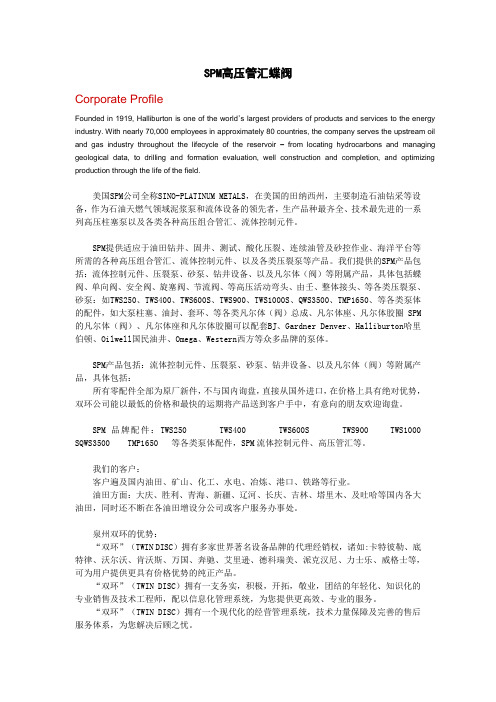
SPM高压管汇蝶阀Corporate ProfileFounded in 1919, Halliburton is one of the world’s largest providers of products and services to the energy industry. With nearly 70,000 employees in approximately 80 countries, the company serves the upstream oil and gas industry throughout the lifecycle of the reservoir –from locating hydrocarbons and managing geological data, to drilling and formation evaluation, well construction and completion, and optimizing production through the life of the field.美国SPM公司全称SINO-PLATINUM METALS,在美国的田纳西州,主要制造石油钻采等设备,作为石油天燃气领域泥浆泵和流体设备的领先者,生产品种最齐全、技术最先进的一系列高压柱塞泵以及各类各种高压组合管汇、流体控制元件。
SPM提供适应于油田钻井、固井、测试、酸化压裂、连续油管及砂控作业、海洋平台等所需的各种高压组合管汇、流体控制元件、以及各类压裂泵等产品。
我们提供的SPM产品包括:流体控制元件、压裂泵、砂泵、钻井设备、以及凡尔体(阀)等附属产品,具体包括蝶阀、单向阀、安全阀、旋塞阀、节流阀、等高压活动弯头、由壬、整体接头、等各类压裂泵、砂泵:如TWS250、TWS400、TWS600S、TWS900、TWS1000S、QWS3500、TMP1650、等各类泵体的配件,如大泵柱塞、油封、套环、等各类凡尔体(阀)总成、凡尔体座、凡尔体胶圈 SPM的凡尔体(阀)、凡尔体座和凡尔体胶圈可以配套BJ、Gardner Denver、Halliburton哈里伯顿、Oilwell国民油井、Omega、Western西方等众多品牌的泵体。
2023中石油职称英语考试真题及答案
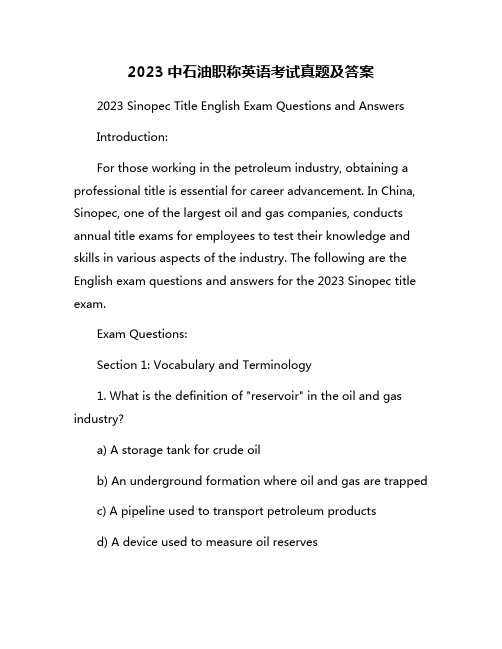
2023中石油职称英语考试真题及答案2023 Sinopec Title English Exam Questions and AnswersIntroduction:For those working in the petroleum industry, obtaining a professional title is essential for career advancement. In China, Sinopec, one of the largest oil and gas companies, conducts annual title exams for employees to test their knowledge and skills in various aspects of the industry. The following are the English exam questions and answers for the 2023 Sinopec title exam.Exam Questions:Section 1: Vocabulary and Terminology1. What is the definition of "reservoir" in the oil and gas industry?a) A storage tank for crude oilb) An underground formation where oil and gas are trappedc) A pipeline used to transport petroleum productsd) A device used to measure oil reserves2. What does the term "upstream" refer to in the petroleum industry?a) Exploration and production of crude oil and natural gasb) Refining and processing of crude oil into petroleum productsc) Transportation and distribution of petroleum productsd) Marketing and sales of petroleum products3. Define the term "fracking" in the context of oil and gas extraction.a) A method of drilling using high-pressure water to extract oil and gasb) A process of sealing wellbores to prevent leaksc) A technique for measuring the viscosity of crude oild) A system for monitoring underground pressure in a reservoirSection 2: Technical Knowledge4. What is the primary purpose of a wellbore in oil and gas drilling?a) To store extracted oil and gasb) To transport oil and gas to the surfacec) To inject water or chemicals into the reservoird) To access and extract oil and gas from underground formations5. What is the typical composition of natural gas?a) Methaneb) Ethanolc) Dieseld) Gasoline6. What is the process of "fractionation" in oil refining?a) Separating crude oil into different components based on boiling pointsb) Mixing different grades of crude oil to create a new productc) Adding additives to improve the quality of gasolined) Collecting natural gas from underground reservoirsSection 3: Case Studies7. A drilling operation in a remote location is facing challenges with equipment maintenance and transportation logistics. How would you address these issues to ensure efficient operations?8. A refinery is experiencing pressure to reduce emissions and improve environmental performance. Provide recommendations for implementing sustainable practices in the refining process.Answers:1. b) An underground formation where oil and gas are trapped2. a) Exploration and production of crude oil and natural gas3. a) A method of drilling using high-pressure water to extract oil and gas4. d) To access and extract oil and gas from underground formations5. a) Methane6. a) Separating crude oil into different components based on boiling points7. To address equipment maintenance challenges, regular inspections and preventive maintenance schedules should be implemented. For transportation logistics, alternative transportation modes such as helicopters or drones can be considered.8. Recommendations for reducing emissions and improving environmental performance in a refinery include investing in pollution control technologies, optimizing energy efficiency, and utilizing renewable energy sources.Conclusion:The 2023 Sinopec title exam is designed to assess employees' knowledge and skills in various aspects of the oil and gas industry. By preparing for and successfully passing this exam, professionals can demonstrate their expertise and competency in their field, leading to career advancement opportunities within the company.。
GIS在长输管道安全上的应用
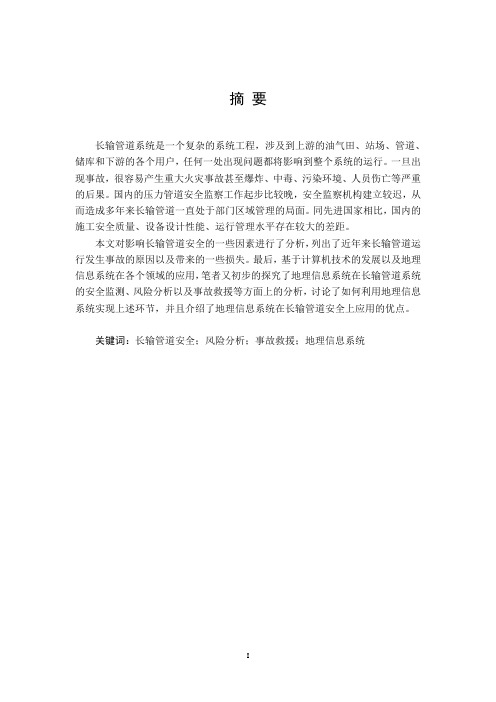
摘要长输管道系统是一个复杂的系统工程,涉及到上游的油气田、站场、管道、储库和下游的各个用户,任何一处出现问题都将影响到整个系统的运行。
一旦出现事故,很容易产生重大火灾事故甚至爆炸、中毒、污染环境、人员伤亡等严重的后果。
国内的压力管道安全监察工作起步比较晚,安全监察机构建立较迟,从而造成多年来长输管道一直处于部门区域管理的局面。
同先进国家相比,国内的施工安全质量、设备设计性能、运行管理水平存在较大的差距。
本文对影响长输管道安全的一些因素进行了分析,列出了近年来长输管道运行发生事故的原因以及带来的一些损失。
最后,基于计算机技术的发展以及地理信息系统在各个领域的应用,笔者又初步的探究了地理信息系统在长输管道系统的安全监测、风险分析以及事故救援等方面上的分析,讨论了如何利用地理信息系统实现上述环节,并且介绍了地理信息系统在长输管道安全上应用的优点。
关键词:长输管道安全;风险分析;事故救援;地理信息系统ABSTRACTLong-distance pipeline system is a complicated system engineering, involves to the upstream oil and gas fields, the station, pipes, reservoir and downstream users, any of the problems will affect the running of the whole system.Once an accident, it is easy to have a significant fire accidents and explosion, poisoning, environmental pollution, casualties and other serious consequences.Domestic pressure pipeline safety supervision work started late, safety supervision institutions to set up later, over the years has been in a long distance gas transmission pipeline is caused by the department of regional management pared with advanced countries,domestic construction safety and quality of design, equipment performance, operation and management level there is a big gap.In this paper, some factors affecting the safety of long-distance pipeline are analyzed, lists the running long distance gas transmission pipeline in recent years some of the cause of the accident and loss,.at last, based on the development of computer technology and geographic information systems in all areas of application, the author has a preliminary study of the geographic information system in the long-distance pipeline system of safety monitoring, risk analysis and the analysis of the accident rescue etc, discussed how to implement the above link using geographic information system, and introduces the geographic information system application in long-distance pipeline security advantages.Key words: long-distance pipeline safety;risk analysis, accident rescue;geographic information system目录摘要 (I)ABSTRACT (II)第1章绪论 (1)1.1研究的背景及意义 (1)1.1.1研究的背景 (1)1.1.2研究的意义 (1)第2章长输管道的主要危险有害因素分析 (3)2.1储运介质危险有害因素分析 (3)2.2储运工艺危险有害因素辨识 (4)2.2.1设计不合理 (4)2.2.2施工质量问题 (5)2.2.3腐蚀失效 (6)2.2.4管道水击 (6)2.2.5 疲劳失效 (7)2.3环境危险有害因素辨识 (8)2.3.1自然环境危险有害因素辨识 (8)2.3.2社会环境危险有害因素分析 (8)2.4安全事故分析与典型事故案例 (9)2.5本章小结 (11)第3章地理信息系统 (13)3.1GIS的简介 (13)3.2 GIS的组成 (13)3.3GIS的功能 (13)3.4国内外GIS的发展历程 (15)3.4.1GIS的国外发展历程 (15)3.4.2GIS的国内发展历程 (15)3.5GIS的应用领域 (15)3.6GIS在国内外GIS在长输管道的应用现状 (17)3.7GIS在长输管道中的发展趋势 (17)第4章基于GIS的长输管道安全的初步探究 (19)4.1 油气管道的数字化与GIS技术 (19)4.2基于GIS技术的油气管道安全管理系统 (19)4.3基于GIS的油气管道事故隐患监控 (20)4.4基于GIS的油气管道事故紧急救援 (21)4.5基于GIS的油气管道风险评估 (22)第5章结论与展望 (25)5.1结论 (25)5.2不足与展望 (25)参考文献 (27)致谢 (28)第1章、绪论1.1研究的背景及意义1.1.1研究的背景作为五大运输方式之一的管道运输是石油天然气的主要运输方式,在石油工业中战友举足轻重的地位3。
PetroChina
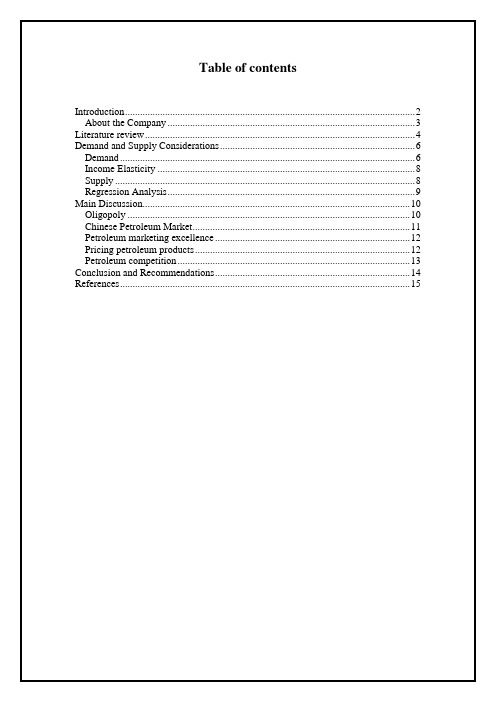
Table of contentsIntroduction (2)About the Company (3)Literature review (4)Demand and Supply Considerations (6)Demand (6)Income Elasticity (8)Supply (8)Regression Analysis (9)Main Discussion (10)Oligopoly (10)Chinese Petroleum Market (11)Petroleum marketing excellence (12)Pricing petroleum products (12)Petroleum competition (13)Conclusion and Recommendations (14)References (15)IntroductionOne of the most important economic sectors of China today is the petroleum sector. Recent concerns about escalating oil prices and rising energy save spending have sparked considerable interest in how new way of more economy are discovered, tested, and sold—and in how well those processes serve the interests of Chinese consumers. Public dialogue on those issues, however, suggests that the complex economic forces that govern the oil-production process are not widely understood.In this project the current market situation in China is firstly described. Furthermore, a descriptive literature review is being ascertained relating the history of the oil industry with the present situation in the oil industry today as well as how the oil is being handled by the various components until it reaches the final consumer. Moreover, there is an analysis of the price and non-price determinants of demand as well as supply for the China reality, followed by a regression analysis of the most important variables affecting the Chinese market. Moreover, the type of market for which the oil industry belongs to is being described.About the CompanyIntroductionPetroChina Company, Limited is a Chinese oil company and is the listed arm of state-owned China National Petroleum Corporation (CNPC), mainland China's biggest producer of oil. It traded in Hong Kong and New York, the mainland enterprise announced its plans to issue stock in Shanghai in November 2007, and following its debut on the Shanghai index, its market value tripled. PetroChina overnight became the first company with a trillion dollar market cap. Similarly, a century earlier, U.S. Steel was the first company with a billion dollar market cap.Company BackgroundThe predecessor of CNPC was the Ministry of Petroleum Industry of the People's Republic of China, which was founded in July 1955, supervising the exploration and development of oil and gas resources in China. China National Petroleum Corporation was established on September 17, 1988 on the basis of the Ministry of Petroleum Industry, mainly in charge of oil and gas upstream operations.On July 27, 1998, China National Petroleum Corporation was reorganized to become an integrated group with businesses covering oil and gas upstream and downstream operations, as well as oilfield services and engineering construction.Important StagesJul. 30, 1955.The Ministry of Petroleum Industry is founded.Sept. 13, 1958.A commercial oil flow is acquired from well Dizhong 4 in the Lenghu area of Qinghai, marking the discovery of the Qinghai Oilfield.Jun. 27, 1971.A commercial oil flow is obtained from well Ling 9 at Maling, Changqing, in the Longdong area of Gansu Province, marking the discovery of the Changqing Oilfield.Sept. 17, 1988.The State Council dissolves the Ministry of Petroleum Industry and China National Petroleum Corporation (CNPC) is established.Oct. 23, 1993.The service contract on Block 7 in Talara Oilfield in Peru is signed, marking the beginning of CNPC's international operations.Jul. 27, 1998.The Chinese government decides to restructure and establish the China National Petroleum Corporation (CNPC) in accordance with the principle of upstream and downstream integration.Oct. 28, 1999.PetroChina Company Limited (PetroChina) is established.Apr. 6, 2000.The American Depositary Shares (ADS) of PetroChina are listed on the New York Stock Exchange.Apr. 7, 2000.The H shares of PetroChina are listed on the Stock Exchange of Hong Kong Limited.CompetitorsExxon Mobil Corporation, or ExxonMobil, is an American oil and gas corporation. It is a direct descendant of John D. Rockefeller's Standard Oil company,[3] and was formed on November 30, 1999, by the merger of Exxon and Mobil.Shell Oil Company is the United States-based affiliate of Royal Dutch Shell, a multinational oil company ("oil major") of Anglo Dutch origins, which is amongst the largest oil companies in the world.Literature reviewPetroleum or crude oil is an oily, flammable liquid that occurs naturally in deposits, most often found beneath the surface of the earth. Over millions of years, plant and animal remains fall to the floor of shallow seas. As the seas draw back, the plant material is covered by sediment layers, such as silt, sand, clay, & other plant material. Buried deep beneath layers of rock, the organic material partially decomposes, under an absence of oxygen, into petroleum that eventually seeps into the spaces between rock layers. As the earth's tectonic plate’s move, the rock is bent or warped into folds or it "breaks" along fault lines, allowing the petroleum to collect in pools.The use of oil and gas has a long and fascinating history spanning thousands of years. The development of oil and gas has evolved over time and its numerous uses have also expanded and become an integral part of today's global economy. The use of oil eventually replaced coal as the world's primary source of industrial power in the early twentieth century. Just as oil drives today's world economy, the control and availability of oil played a major role in both World Wars and still remains the critical fuel source that powers industry and transportation.Petroleum is vital to nearly all industries, if not industrialized civilization itself, and thus is critical concern to many nations. Oil accounts for a large percentage of the world’s energy consumption, ranging from a low of 32% for Europe, Eurasia, and the Asia Pacific region, up to a high of 53% for the Middle East. Other geographic regions’ consumption patterns are as follows: South and Central America (44%), Africa (41%), and North America (40%). The world at large consumes 30 billion barrels (4.8 km³) of oil per year, and the top oil consumers largely consist of developed nations.Marketing is the wholesale and retail distribution of refined petroleum products to business, industry, government and public consumers. The price paid by consumers is intricately linked to the fact that oil is the major commodity of international trade. In other words, the oil industry is influenced by economic and political conditions. Other factors influencing price are rig utilization rates and oil contracts.Generally crude oil and petroleum products flow to the markets that provide the highest value to the supplier, which usually means the nearest market first because of lowest transportation cost and higher net revenue for the supplier.However, one of the most powerful modern cartels is the Organization of the Petroleum Exporting Countries more commonly referred to as OPEC. OPEC is a permanent, intergovernmental organization created at the Baghdad Conference on September 10-14, 1960. Prior to the rise of OPEC, the oil industry was dominated by the large oil companies often known as the Seven Sisters. OPEC was born, to some extent, to reduce the influence the oil multinationals. OPEC technically doesn't set oil prices, but because the OPEC countries produce about 40% of the world's oil supply and their exports account for about 55% of the total export in oil, their decisions doindividuals or entities in China and operate in different cities and towns in China. On the other hand, government purchasing operates with Chinese public departments. Some special products require a officer’s written prescription before being purchased.Ever since its establishment in China, PetroChina had strived to meet the increasing demand of petroleum in the nation. With headquarters in Beijing, the company is operating with collaboration with the Ministry of Petroleum Industry, Car Company, organizations of petroleum, and others. This collaboration is helping the company meet the demand in China and attain a good reputation in the market. The future of demand on petroleum in China is rising and the company is to meet this rise.The law of demand, in theory, states that there is an inverse relationship between the price of a good and the quantity demanded. But there are also non-price determinants of demand, these include: the change in the consumer's taste, change in the buyer’s income, change in price of related goods and change in the number of buyers. The figures show how demand changes with the change in price and with the change with the non price determinants:A change in Price A change in non-price determinantsIncome ElasticityOil is more of a need to human beings than wants. They are part of our daily life. As we know, the resource of oil, all over the world, become less and less than the needs of human. If you have a car, but without fuel, what can it do? Everything which will be did by this car will not be done. So logically, petroleum products are more of a necessity than a normal good.An economic definition of income elasticity is the percentage change in the quantity demanded of a good for a one percent change in the income. It is expressed in the formula below:€I= (ΔQ/Q) / (ΔI/I)SupplyAs we have examined with demand there are some determinants that affect the position of the demand curve (rightward or leftward movement). In a similar way the same happens with the supply. The determinants are distinguished in price and non price determinants, whereas the non price determinants can move the supply curve rightward or leftward. Like in demand a possible movement of the supply curve can affect the equilibrium position and continually affect the incomes and revenues of a company. For this reason every petroleum company ought to study these determinants and seek ways to alter them so that they can help the organization to increase its profits.In theory, the Law of Supply states that a decrease in the price of a good, holding all other things constant, will lead to a decrease in the quantity supplied of this good and vice versa. A change in the non-determinants of supply will cause a shift of the supply curve. These non-determinants include: production technology, input prices, number of sellers (pharmacies), taxes, price expectations and other factors. The figures below show how the supply would change:A change in Price A change in non-price determinantsRegression AnalysisRegression analysis is used when you want to predict a continuous dependent variable from a number of independent variables. With regression analysis the relationships among the variables cannot be determined. While the terminology is such that we say that X "predicts" Y, we cannot say that X "causes" Y.Regression analysis is used to produce an equation that will predict a dependent variable using one or more independent variables. This equation has the form Y = b1X1 + b2X2 + ... + Awhere Y is the dependent variable you are trying to predict, X1, X2 and so on are the independent variables we are using to predict it, b1, b2 and so on are the coefficients or multipliers that describe the size of the effect the independent variables are having on our dependent variable Y, and A is the value Y is predicted to have when all the independent variables are equal to zero.When running the regression, we are trying to discover whether the coefficients on our independent variables are really different from 0 (so the independent variables are having a genuine effect on the dependent variable) or if alternatively any apparent differences from 0 are just due to random chance. The null (default) hypothesis isalways that each independent variable is having absolutely no effect (has a coefficient of 0) and we are looking for a reason to reject this theory.The t statistic is the coefficient divided by its standard error. The standard error is an estimate of the standard deviation of the coefficient, the amount it varies across cases. It can be thought of as a measure of the precision with which the regression coefficient is measured. If a coefficient is large compared to its standard error, then it is probably different from 0.The P value is the probability of seeing a result as extreme as the one we are getting in a collection of random data in which the variable had no effect. A P of 5% or less is the generally accepted point at which to reject the null hypothesis. With a P value of 5% (or .05) there is only a 5% chance that results you are seeing would have come up in a random distribution, so we can say with a 95% probability of being correct that the variable is having some effect, assuming your model is specified correctly. The P value tells us how confident we can be that each individual variable has some correlation with the dependent variable.The 95% confidence interval for our coefficients shown that we can be 95% confident that the real, underlying value of the coefficient that we are estimating falls somewhere in that 95% confidence interval, so if the interval does not contain 0, our P value will be .05 or less. (See appendix)Main DiscussionOligopolyPetroleum companies are operated in an oligopoly market. Oligopoly is a market that dominated by a few large suppliers. The degree of market concentration is very high. Firms within an oligopoly produce branded products (advertising and marketing is an important feature of competition within such markets) and there are also barriers to entry.Another important characteristic of an oligopoly is interdependence between firms. This means that each firm must take into account the likely reactions of other firms in the market when making pricing and investment decisions.Above the kink, demand is rela tively elastic because all other firm’s prices remain unchanged. Below the kink, demand is relatively inelastic because all other firms will introduce a similar price cut leading, eventually, to a price war. Therefore, the best option, for the oligopolist, is to produce at point E which is the equilibrium point and, incidentally, the kink point.To sum up, in an oligopoly, firms operate under imperfect competition, the demand curve is kinked to reflect inelasticity below market price and elasticity above market price, the product or service firms offer are differentiated and barriers to entry are strong. Following from the fierce price competitiveness created by this sticky-upward demand curve, firms utilize non-price competition in order to accrue greater revenue and market share.Chinese Petroleum MarketAs many countries, Chinese petroleum market is divided into two distinct sectors: public and private. These operate independently at all levels.The public sector is funded by the Government Resources Services through budgets approved by parliament and included in the national budget every financial year. Customer coverage is dependent on financial status criteria, where 80% of allproducts in this sector are provided free to the government and the army. All products in the public sector are available through related department only.Petroleum marketing excellenceChinaPetro’s marketing initiative implements progr ammes to overcome the barriers to reduce costs, by providing accurate and balanced information on its products, to allow more and more people to benefit from ChinaPetro’s technology advances. While these programmes are beginning to show effects, more needs to be done before the societal costs of resource will decrease.Pricing petroleum productsThe retailing price of gasoline at a petrol station of PetroChina reflects a series of phases until the oil reaches the final consumer. Firstly, the oil is being purchased by the refiner. There is also t he refiner’s processing and distribution costs and profits. Other costs include the retail distribution, marketing and station operating costs and profits (and sometimes losses). Furthermore, in many cases there are state taxes.Components of the retail price:Crude oil: 46%Refining costs and profits: 14%Retail distribution, marketing, and station operations: 12%National taxes: 28%.In general, PetroChina does not set wholesale or retail prices based solely upon the cost to manufacture and sell gasoline but they are set on the basis of market conditions, including the prices of competitors. Although retail prices can be broken down into the four components mentioned above, neither refining nor retail prices are established on a cost-plus-profit basis.The wholesale price is determined largely by the factors influencing the current supply and demand situation, including the market’s outlook for the future. Similarly, the price a retailer will charge for gasoline will reflect prevailing market conditions, including the retail prices of nearby competitors.For the market, PetroChina tries to maintain their prices at a constant price difference in respect to their competitors. As a consequence of these mutually dependent practices, gasoline prices of oil companies tend to go up and down together.One of the determining factors for price is the tax imposed by the Chinese government. The government has the complexity of ensuring that marketing companies make satisfactory profits whilst keeping prices, at the same time, low and stable due to internal and external political forces.As we know, China is a nation which has enriches oil resource. But it doesn't have ability to decide price of oil of international market. There are still some products of petroleum need to import. Prices of oil have currently increased in relation to previous years. For PetroChina, with crude oil imports at a level of 30% for total demand and likely to go up to 40% in the near future, there are just a few options to moderate domestic prices when international prices increase.Petroleum competitionThe petroleum industry is low competitive. PetroChina’s principal major competitors are large petroleum companies often with substantial resources.Pharmaceuticals may be subject to competition from other products during the period of patent protection and, once off patent, from generic versions. The manufacturers of generic products typically do not bear significant research and development or education and marketing development costs and consequently are able to offer their products at considerably lower prices than the branded competitors.PetroChina believes that remaining competitive is dependent upon the discovery the new oilfield and increase the share of the market, together with effective marketing of existing products. Within the petroleum industry, the development of new oilfield and processes by competitors may affect pricing levels or result in changing patterns of product use. There can be no assurance that products will become more effective, notwithstanding patent or industry protection. In addition, increased government and other policies for the companies of petroleum which come from other countries areallowed to entry the Chinese petroleum market, rather than local brand, may increase competition for products that are no longer protected by industry.Conclusion and RecommendationsOver the past 10 years, changes for price of international oil are affected by the relationship of supply and demand, the U.S. dollar and speculation three factors. The basic direction of oil prices is determined by changes in supply and demand and the dollar, but speculation enlarges the scope of fluctuating of oil prices. From the pattern of supply and demand of global oil, the world economic recovery will drive the growth of oil demand, but the supply growth is dependent on OPEC increasingly. Since 2002 non-OPEC oil production began to decline, global oil supply has begun to add highly dependent on OPEC oil producers, but the decline in global oil investment affects the supply of growth in the future adversely in the last two years.So, for my own idea, marketing company, such as PetroChina, must be allowed to earn their margins and operate profitably. The missing element of true competition in the marketplace will appear once the private marketers are able to establish a sizeable network. At some stage, the government will have to bite the bullet and give oil companies full freedom to set prices. The opportunity may soon arise if crude prices maintain their move southwards. Rolling forward or rolling back should be by the market and not a gymnastics exercise by the government. With a regulator hopefully in place to establish the system of price monitoring, the government would finally get rid of the old man on its back.ReferencesLeblond, D. (2007) IFP: Oil, natural gas prices to remain high for 2007-08. Oil and Gas Journal, 105(9), pp. 30-32.Mehrara, M. (2007) Energy consumption and economic growth: The case of oil exporting countries. Energy Policy, 35(5), pp. 2939Pagoulatos, A. (1979) Major Determinants Affecting the Demand and Supply of Energy Resources. New York, Arno Press.Wikipedia, (2007) Petroleum industry, [Online],Available: /wiki/Oil_industryGallagher, K. (2006) China Shifts Gears: Automakers, Oil, Pollution, and Development,[Online],Available:/publication.cfm?program=CORE&ctype=book &item_id=470Jahn, G. (2007) OPEC likes status quo on crude for now / Ministers say production not likely to increase. Houston Chronicle, March, pp. 6Keat, P.G., and Young, P.K., (2003) Managerial Economics, New Jersey: Pearson Education, 4th edition.National Bureau of Statistics of China, China Statistical Yearbook 2008, [Online], Available: /tjsj/ndsj/2008/indexch.htmAppendices-Global Economics and Energy。
OilAndGas_cn1
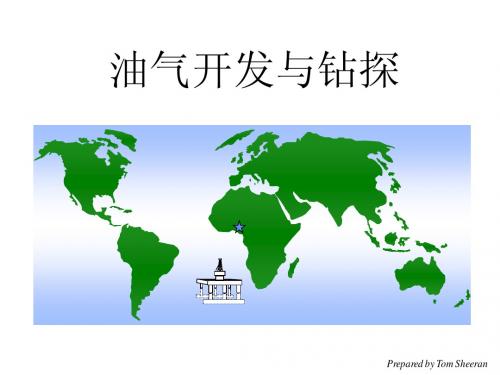
钻井设备: 一套可以使我们钻入地层的特殊设备。
• 一套钻井设备由很多不同的部分组成: 井架,地基,起重设备,发电机,钻杆,钢罐,泵, 岩石碎屑处理设备,还有很多其他部件。 • 你知道有的钻井设备可以钻探到地下6英里(9.7公里) 深的地方吗? 那比珠穆朗玛峰的高度还要大!
Prepared by Tom Sheeran
为什么我们要假设气体在顶部?
Prepared by Tom Sheeran
我们如何找到这些油藏呢?
• 地球物理学家通过油藏反射的声波找到它们,计录声波 反射回来的时间 • 计算机处理这些数据,构造出地下岩层系统的图像
声源 t = 1 sec
t = 1.2 sec
t = 1.42 sec
接收器
Gas 油
Prepared by Tom Sheeran
石油和天然气就是这样来的!
完
Prepared by Tom Sheeran
About the Author: Tom Sheeran has been working in the oil and gas industry for over 18 years. He worked summers on a drilling rig while going to school to earn a degree in Petroleum Engineering. After graduating, he went to work for Chevron in the Rocky Mountains. In 1990 he began working for Chevron Overseas Petroleum, and since then has worked all over the world, in Scotland, Australia, Papua New Guinea, Venezuela, Angola and Nigeria. Tom is currently employed by Chevron Nigeria Ltd. and is living and working as a resident in Lagos, Nigeria. Tom and his wife Shallini have 2 children, and home-schooled in the U.S. for several years before moving overseas. Tom developed this presentation for kids so they may learn more about the oil industry. You may contact Tom at: Tom A. Sheeran Sr. Drilling Engineer Chevron Nigeria Ltd. SHTA@
四川盆地海相碳酸盐岩天然气资源量储量转换规律

四川盆地海相碳酸盐岩天然气资源量储量转换规律战薇芸1 刘辉1 陈尘1 李海涛1 吴雪峰1 未勇21.中国石油西南油气田公司勘探开发研究院2.中国石油西南油气田公司摘 要 分析油气资源潜力、预测新增探明储量规模是合理编制储量、产量规划方案、制定中长期发展战略的基础。
根据资源量、储量转换规律可以进一步评价、落实资源升级潜力。
通过研究已升级气藏储量转换规律,分析各项储量计算参数与储量在升级转换中的相关性,明确影响储量升级转换的关键因素并计算转换率。
根据已发现圈闭,利用圈闭钻探成功率、储量计算参数升级转换率测算资源量、储量升级转换率,最终预测新增探明储量规模。
该方法以资源量、储量升级规律为依据,以目前勘探发现为基础,可以较为精确地预测新增储量规模。
研究结果表明:①含气面积是引起储量升级变化的最关键因素,其次是有效储层厚度、有效孔隙度、含气饱和度等参数;②储量升级中,构造气藏含气面积变化最小,岩性气藏含气面积变化最大,储量丰度变化相对较小;③四川盆地海相碳酸盐岩从资源量到预测储量转换率43%左右,三级储量转换率介于60%~75%;④根据资源量、储量升级转换率,以可升级圈闭为基础,预测四川盆地海相碳酸盐岩可新增探明储量约1.8×1012 m3。
关键词 四川盆地 海相碳酸盐岩 资源潜力 转换规律 储量参数 储量升级转换率 新增储量预测DOI:10.12055/gaskk.issn.1673-3177.2020.04.005Rules on conversion of natural-gas reserves to resources inmarine carbonate rocks, Sichuan BasinZhan Weiyun1, Liu Hui1, Chen Chen1, Li Haitao1, Wu Xuefeng1, and Wei Yong2(1. Exploration and Development Research Institute, PetroChina Southwest Oil & Gasfield Company, Chengdu, Si-chuan 610041, China;2. PetroChina Southwest Oil & Gasfield Company, Chengdu, Sichuan 610051, China) Abstract: Both analyzing oil and gas resource potential and predicting additional proven reserves are the foundation to reasonably compile reserve and production plans and formulate middle- and long-term development strategies. The upgrading potential of oil and gas resources can be evaluated and confirmed further according to conversion rules on resources and reserves. Based on an in-vestigation on these rules of upgraded gas reservoirs, the correlation of upgrading conversion between reserve calculation parameters and reserves was analyzed. Then, the key factors affecting this conversion were clarified, and the conversion rate was calculated. The resource and reserve upgrading conversation rate was calculated according to discovered traps, combined with the success rate of trap drilling and the upgrading conversion rate of reserve calculation parameters, and eventually the additional proved reserves were predicted. With resource and reserve upgrading rules as the basis and the current exploration discoveries as the foundation, the above ways can predict the additional reserves more accurately. Results show that, (1) gas-bearing area is the most important factor affecting reserve upgrading, followed by effective reservoir thickness, porosity, and gas saturation; (2) for reserve upgrading, the gas-bearing area variation of structural reservoirs is the smallest and that of lithologic ones is the largest. And the reserve abundance varies less;(3) the conversion rate of predicted reserves from the resources in marine carbonate rocks of Sichuan Basin is about 43%, and the con-version rate of 3P reserves ranges from 60% to 75%; and (4) based on the upgradable traps, it is predicted according to the resource and the reserve upgrading conversion rate that the additional proved reserves in these carbonate rocks is about 1.8×1012 m3. Keywords: Sichuan Basin; Marine carbonate rock; Resource potential; Conversion rule; Reserve parameter; Reserve upgrading con-version rate; Prediction of additional reserves.基金项目:中国石油西南油气田公司科学研究与技术项目“四川盆地天然气发展战略—资源储量产量转化规律及增长趋势预测研究”(编号:20190310-03)。
译文笔记
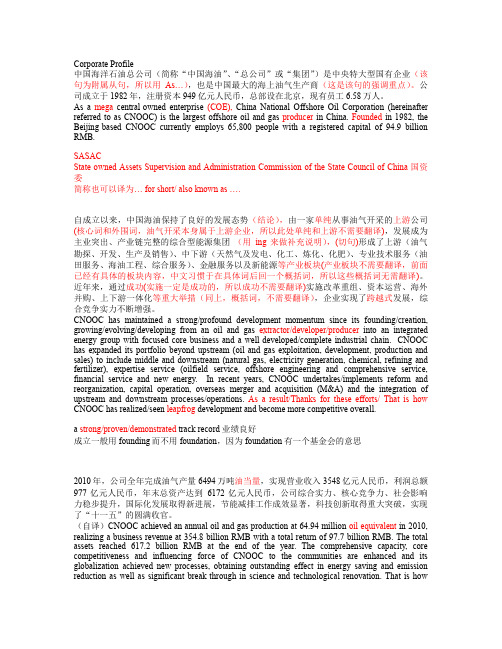
Corporate Profile中国海洋石油总公司(简称“中国海油”、“总公司”或“集团”)是中央特大型国有企业(该句为附属从句,所以用A s…),也是中国最大的海上油气生产商(这是该句的强调重点)。
公司成立于1982年,注册资本949亿元人民币,总部设在北京,现有员工6.58万人。
As a mega central-owned enterprise(COE), China National Offshore Oil Corporation (hereinafter referred to as CNOOC) is the largest offshore oil and gas producer in China. Founded in 1982, the Beijing-based CNOOC currently employs 65,800 people with a registered capital of 94.9 billion RMB. SASACState-owned Assets Supervision and Administration Commission of the State Council of China 国资委简称也可以译为… for short/ also known as ….自成立以来,中国海油保持了良好的发展态势(结论),由一家单纯从事油气开采的上游公司(核心词和外围词,油气开采本身属于上游企业,所以此处单纯和上游不需要翻译),发展成为主业突出、产业链完整的综合型能源集团(用ing来做补充说明),(切句)形成了上游(油气勘探、开发、生产及销售)、中下游(天然气及发电、化工、炼化、化肥)、专业技术服务(油田服务、海油工程、综合服务)、金融服务以及新能源等产业板块(产业板块不需要翻译,前面已经有具体的板块内容,中文习惯于在具体词后回一个概括词,所以这些概括词无需翻译)。
中石油介绍 英文

China National Petroleum Corporation (CNPC) is an integrated international energy company. Based in China, we have oil and gas assets and interests in 30 countries in Africa, Central Asia-Russia, South America, the Middle East and the Asia-Pacific.CNPC is China's largest oil and gas producer and supplier, as well as one of the world's major oilfield service providers and a globally reputed contractor in engineering construction, with businesses covering petroleum exploration & production, natural gas & pipelines, refining & marketing, oilfield services, engineering construction, petroleum equipment manufacturing and new energy development, as well as capital management, finance and insurance services.Crude output: 2.75 million barrels/dayNatural gas output: 7.22 billion cubic feet/dayCrude oil production: 54.4% of the nation's totalNatural gas production: 82.3% of the nation's totalCrude runs: 2.70 million barrels/dayDomestic service stations: 17,262(Data as of December 31, 2009).Domestic pipelines: 50,652 kilometers, including 13,189 kilometers for crude oil (nearly 70% of the nation's total), 28,595 kilometers for natural gas (nearly 90% of the nation's total) and 8,868 kilometers for refined products (nearly 50% of the nation's total)Providing oilfield services and engineering construction in 49 countries around the world.To be a world-leading integrated international energy company with the general business portfolio of an international energy corporation and the characteristics of China's national energy corporation.Our Mission:Caring for Energy, Caring for You;Energize • Harmonize • RealizeChina National Petroleum Corporation (CNPC) is committed to "Caring for Energy, Caring for You". We strive for harmonious relationships between operations and safety, energy and the environment, corporate and community interests, and employers and employees.Our Values and Operating Principles:Dynamic, loyal, honest, committed;Achieving excellence through innovation and integrityOur StrategyIncreasing resourcesEndeavoring to maximize and diversify oil and gas resources, ensuring an orderly replacement of reserves, and maintaining the domestic leadership of our upstream business.Expanding marketTaking full advantage of economies of scale and the integration of upstream and downstream operations to seek a dominant position in the market and maximize profits.Seeking a greater international roleFocusing on oil and gas business, being active and prudent in enhancing international cooperation, strengthening capital operations, and expanding international oil and gas trading in a mutually beneficial way.Our Goal: To build an integrated international energy corporationFocusing on oil and gas business supplemented by oilfield engineering and technical services, integrating upstream and downstream operations, developing our domestic and overseas businesses in a coordinated way and promoting the orderly development of new energy.CNPC's Logo and Brand1. The History of Our LogoCNPC's logo embodies our commitment to ensuring harmony between the development of energy and the environment. The flower-shaped logo's colors are those of China's national flag, with its ten petals representing our core businesses. The solid red base illustrates CNPC's strength and cohesion as a state-owned enterprise, while the rising sun highlights our brilliant future.The acronym "CNPC" has a history of more than 20 years. Our flower-shaped logo and its two-color combination (red and yellow) make the CNPC brand stand out and greatly enhance our company's popularity cognition degree. The logo represents not only the quality of our products and services, but also our professional service capabilities and values.As our core brand, CNPC represents what we do and what we expect to achieve in the future.2. Our Core BrandCNPC is our main global brand, which exists on our oil production platforms, refineries, equipment manufacturing products and in the offices of the company, as well as on our lubricating oil products and service stations.The acronym CNPC first appeared in public in 1998 and, thanks to our quality products and good service, the brand has become well known to millions of customers.Harmony is part of our brand values, as well as the way in which we manage our company's relationships with society, our employees and our customers. We strive to realize harmonious development in all respects through our hard work, broad vision and creativity. In fact, this value has already been integrated into the company's business operations. In addition to harmony, our brand values also include honesty, innovation, performance and safety.3. KunlunCNPC launched the "Kunlun" petrochemical products brand in 2001, with "caring" as its core value, which has strengthened interaction and communication between CNPC and its consumers. The values of the brand are "caring for your machines, caring for our consumers, caring for nature and caring for our employees".China National Petroleum Corporation and PetroChina Company Limited registered "Kunlun "(Chinese characters) and "Kunlun" text and graphics trademarks respectively in different categories and services, and also registered them with the following organizations and conventions: World Intellectual Property Organization, Intellectual Property Department of Hong Kong Special Administrative Region of China, Myanmar trademark owner affidavit, etc.History of the Kunlun BrandIn August 2001, the Kunlun brand first appeared as a lubricating product, just one of a number of reliable lubricating product brands offered by CNPC.In September 2003, Kunlun took the lead in the medium- and high-end lubricant markets in China, and then the company positioned the "Kunlun" brand's core value as "caring".In February 2005, CNPC integrated its competitive lubricant and petrochemical brands and launched the new "Kunlun" brand, making it synonymous with CNPC's high-end lubricants and chemical products. Kunlun became one of the top five lubricants in terms of global market share. CNPC EQUIPMENT"CNPC EQUIPMENT" brand was officially launched on September 28, 2009. As an endorsed brand, it will be tied to the original registered trademarks of authorized equipment products.The values of the brand are "Strive for excellence, Serve the energy industry". We, focusing on quality and customer's satisfaction, with market as orientation and technology as breakthrough, are committed to enhance the strength and value of CNPC manufacturing business. We endeavor tostrengthen technological innovation, promote industrial upgrade, speed up the change of growth mode, continuously increase competitiveness and build an integrated brand of CNPC equipment. HistoryThe predecessor of CNPC was the Ministry of Petroleum Industry of the People's Republic of China, which was founded in July 1955, supervising the exploration and development of oil and gas resources in China.China National Petroleum CorporationChina National Petroleum Corporation was established on September 17, 1988 on the basis of the Ministry of Petroleum Industry, mainly in charge of oil and gas upstream operations. It is a state oil company endowed with certain governmental administrative functions.China National Petroleum Corporation (Group)On July 27, 1998, China National Petroleum Corporation was reorganized to become an integrated group with businesses covering oil and gas upstream and downstream operations, as well as oilfield services and engineering construction.PetroChina was established under the Company Law and the Special Regulations on the Overseas Offering and Listing of Shares by Joint Stock Limited Companies on November 5, 1999. The American Depositary Shares (ADS) and H shares of PetroChina were listed on the New York Stock Exchange on April 6, 2000 (stock code: PTR) and the Stock Exchange of Hong Kong Limited on April 7, 2000 (stock code: 857) respectively. It was listed on Shanghai Stock Exchange on November 5, 2007 (stock code: 601857). By the end of 2007, China National Petroleum Corporation possessed 86.29% of PetroChina shares.CNPC's major refined products include gasoline, kerosene, diesel, lube oil, chemical light oil, fuel oil, solvent oil, paraffin, bitumen, petroleum coke and LPG.FuelGasolineWe offer automobile gasoline, automobile alcohol fuel and aviation gasoline. Automobile gasoline covers the 90#, 93#, 95#, 97# and 98# grades. Our increasing investment in scientific research and the continuous improvement of our refining technologies enable us to offer high-grade and clean automobile gasoline products.DieselDiesel generally fuels compression-ignition engines in trucks, tractors, diesel locomotives and ships. CNPC's service stations typically supply diesoline covering six grades. In the descending order of their freezing point, these grades are: 10#, 0#, -10#, -20#, -35#, and -50#.KeroseneOur kerosene products mainly include lamp oil and 3# aviation jet fuel which meet corresponding technical requirements. Our standard for 3# aviation jet fuel is defined according to the quality standards of kerosene-type jet fuel such as JetA-1 and JP-8 of the US, DERD2494 of the UK, and the standard of the IATA (International Air Transport Association).LPG: CNPC has LPG service stations in major Chinese cities providing LPG for automobiles, as well as heating, domestic and commercial applications.ParaffinCNPC produces different paraffin products from its abundant resources. Its crude oil from the Daqing and Shenbei oilfields is world-renowned high paraffin-content oil that has a paraffincontent of 25% and 42% respectively. This unique, scarce resource of high-paraffin-base crude gives CNPC great advantages in the production of quality paraffin products. CNPC has the only high-pressure paraffin hydrofining unit in China. Designed to run at a pressure as high as 18Mpa, this unit can produce food-grade paraffin products and high-melting-point paraffin products. Our fully refined paraffin meets the non-toxicity and benzene requirements of many countries, and is the only paraffin product exempted from FDA inspection before its entry to the American market. Lube oilWe produce Kunlun brand lube oil and grease using premium base oil. Our flagship products include the Tianrun, Tianlai, Tianxie, Tianwei, Tianhong, Tianli and Tiansheng series, satisfying market demand for high-grade car lubricants, motorcycle lubricants and diesel engine oils. With the base oil hydrocracking technique, we produce lube products that are more environmentally friendly. Kunlun lube has been designated for the assembly and service of Deutz, a German manufacturer of top-class heavy-duty diesel engines. Maersk Sealand has three global lubricant suppliers, of which CNPC is the only one from China.1. Car Lubricants2. Lubricants for Medium and High-grade Commercial Vehicles3. Lubricants for Heavy-duty Commercial Vehicles4. Medium-grade and Normal Commercial Vehicle Lubricants5. Lubricants for Engineering Machinery6. Elevator Oil7. Motorcycle OilBitumenCNPC is one of the most important bitumen product suppliers in China and produces Kunlun brand premium bitumen products. Suitable crude oil is crucial for quality bitumen production. Our bitumen products made from heavy oil from the Xinjiang and Liaohe oilfields have excellent thermal stability, low-temperature extensibility, cohesiveness and low paraffin content. They are widely used in expressways, urban roads, airport runways, autodromes, bridge pavements and hydraulic engineering. Our base bitumen for airports is a special product that allows for onsite polymer modification. Assessment of its application at ten airports including Xining Airport, Yan'an Airport and Qingdao Liuting International Airport has indicated that Kunlun airport runway pavement bitumen demonstrates excellent resistance to rolling at high temperatures and cracking at low temperatures, perfect aging resistance and resistance to permanent deformation, as well as good storage stability and compliance with all special technical specifications for bitumen runway pavements. CNPC's major bitumen products include 70#, 90#, and 110# heavy-duty road bitumen, 100# and 140# road bitumen, 10# building bitumen and SBS modified bitumen.。
雪佛龙公司中英文简介
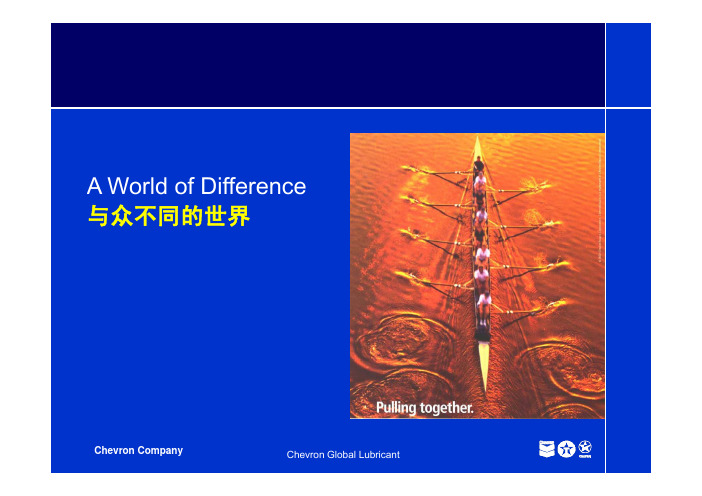
A World of Difference A World of Difference与众不同的世界Chevron CompanyContent内容Chevron Introduction 雪佛龙公司介绍Caltex Overview加德士简介Chevron in China雪佛龙在中国Chevron CompanyChevron Introduction 雪佛龙公司介绍Chevron CompanyA NEW SYMBOL FOR A GLOBAL ENERGY COMPANY全球性能源公司的一个新的代号Chevron CompanyChevron: A World Class Global Energy Company 雪佛龙个世界级的球性能源公司雪佛龙:一个世界级的全球性能源公司Chevron CompanyChevron 雪佛龙Presence in 180 countries在180个国家营业Enterprise value of approx. USD 100 billion公司市值约1200亿美元4th largest publicly traded company in terms of Oil and Gas g p y p yreserves of 11.5 billion barrels equivalent世界第四大石油与天然气公司并拥有115亿桶储备4th largest producer with a daily production of 2.7million barrels世界第四大石油产品生产商,每天产量270万桶6th largest company in 2008 fortune 500 company2008年度财富500强排名第6位Chevron CompanyChevron Businesses 雪佛龙业务Exploration and Production (upstream)p (p )勘探与生产(上游)Refining/Marketing/Transportation (Downstream)Refining/Marketing/Transportation (Downstream)提炼、营销与运输(下游)Chemicals化工Power Generation and Gasification Power Generation and Gasification发电与汽化Ad d E T h lAdvanced Energy Technology先进能源技术Chevron CompanyChevron -Exploration and Production (Upstream)雪佛龙开采与生产(上游)雪佛龙:开采与生产(上游)a leader in worldwide liquids and natural gas production世界领先的液化与天然气生产商Major producing areas主要生产区域North America: Gulf of Mexico, California, Texas and CanadaNorth America:Gulf of Mexico,California,Texas and Canada北美:墨西哥湾、加拿大,美国加州、德克萨斯International: Kazakhstan, Angola, Nigeria, Republic of Congo, Venezuela, Australia,Indonesia, Thailand, China, Papua New Guinea, North Sea and Middle East国际:勘撒克斯坦、安哥拉、尼日尼亚、刚果、委内瑞拉、澳大利亚、印度尼西亚、泰国、中国、新几内匹、北海和中东。
中国南海深水优快钻井技术探索与应用
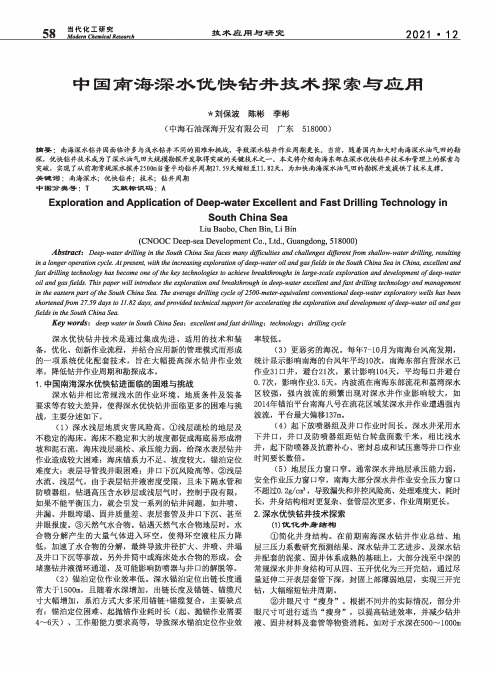
当代化工研究Modem Chemical Research58技术应用与研究2021•12中国南海深水优快钻井技术探索与应用*刘保波陈彬李彬(中海石油深海开发有限公司广东518000)摘耍:南海深水钻井因面临许多与浅水钻井不同的困难和挑战,导致深水钻井作业周期更长.当前,随着国内加大对南海深水油气田的勘探,优快钻井技术成为了深水油气田大规模勘探开发取得突破的关键技术之一.本文将介绍南海东部在深水优快钻井技术和管理上的探索与突破,实现了从前期常规深■水探井2500m当量平均钻井周期27.59天缩短至11.82天,为加快南海深水油气田的勘探开发提供了技术支撑.关键词:南海深水;优快钻井;技术;钻井周期中国分类•号:T文献标识码:AExploration and Application of Deep-water Excellent and Fast Drilling Technology inSouth China SeaLiu Baobo,Chen Bin,Li Bin(CNOOC Deep-sea Development Co.,Ltd.,Guangdong,518000)Abstractz Deep-water drilling in the South China Sea f aces many difficulties and challenges different f rom shallo^-^ater drilling,resulting in a longer operation cycle.At p resent,with the increasing exploration of d eep-water oil and g as f ields in the South China Sea in China,excellent and fast drilling technology has become one of t he key technologies to achieve breakthroughs in large-scale exploration and development of d eep-water oil and gas f ields.This paper will introduce the exploration and breakthrough in deep-water excellent and f ast drilling technology and management in the eastern part of t he South China Sea.The average drilling cycle of2500-meter-equivalent conventional deep-water exploratory wells has been shortened f rom27.59days to11.82days,and p rovided technical support f or accelerating the exploration and development of d eep-^ater oil and gas fields in the South China Sea.Key words:deep water in South China Sea;excellent andfast drilling;technology^drilling cycle深水优快钻井技术是通过集成先进、适用的技术和装备,优化、创新作业流程,并结合应用新的管理模式而形成的一项系统优化配套技术,旨在大幅提高深水钻井作业效率,降低钻井作业周期和勘探成本。
中国石油英文简介
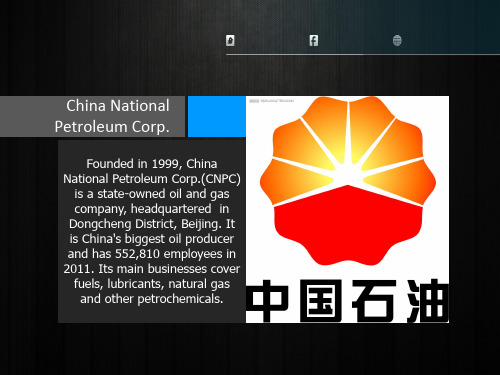
0605Βιβλιοθήκη 040302
01
China National Petroleum Corporation (CNPC) is committed to "Caring for Energy, Caring for You". We strive for harmonious relationships between operations and safety, energy and environment, corporate and community interests, and employers and employees. We are committed to protecting the environment and saving resources, promoting the research, development and application of environmentally friendly products, fulfilling our responsibilities to society and promoting development that benefits all. In 2012, China National Petroleum Corp. ranked the 2rd in the Top 500 corporations. In the future, CNPC will focus on developing our domestic and overseas businesses in a coordinated way and strive to be a world-leading integrated international energy corporation.
油气英语
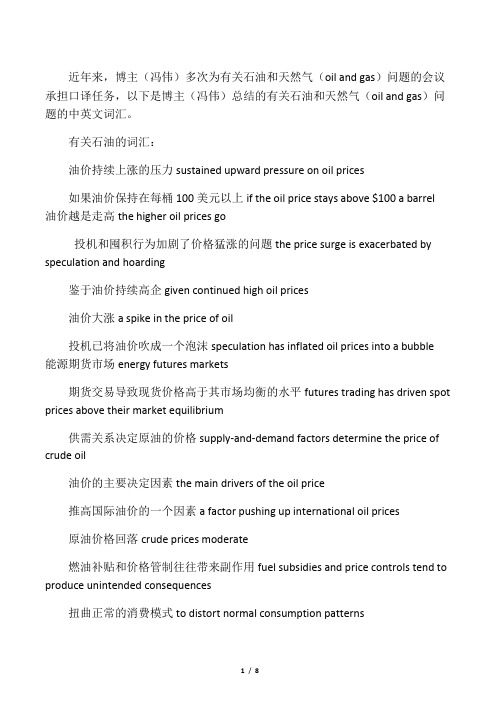
近年来,博主(冯伟)多次为有关石油和天然气(oil and gas)问题的会议承担口译任务,以下是博主(冯伟)总结的有关石油和天然气(oil and gas)问题的中英文词汇。
有关石油的词汇:油价持续上涨的压力sustained upward pressure on oil prices如果油价保持在每桶100美元以上if the oil price stays above $100 a barrel油价越是走高the higher oil prices go投机和囤积行为加剧了价格猛涨的问题the price surge is exacerbated by speculation and hoarding鉴于油价持续高企given continued high oil prices油价大涨a spike in the price of oil投机已将油价吹成一个泡沫speculation has inflated oil prices into a bubble能源期货市场energy futures markets期货交易导致现货价格高于其市场均衡的水平futures trading has driven spot prices above their market equilibrium供需关系决定原油的价格supply-and-demand factors determine the price of crude oil油价的主要决定因素the main drivers of the oil price推高国际油价的一个因素a factor pushing up international oil prices原油价格回落crude prices moderate燃油补贴和价格管制往往带来副作用fuel subsidies and price controls tend to produce unintended consequences扭曲正常的消费模式to distort normal consumption patterns违反供需定律to subvert the law of supply and demand进一步加大供应压力to strain supplies further供需失衡supply-demand imbalance让其国内成品油价格与国际价格接轨to bring its domestic oil product prices in line with international ones深水勘探deep-water exploration分成合同production-sharing contracts重质原油heavy crude超重质原油extra-heavy crude石油品质高oil is of high quality石油品质低oil is of inferior quality含硫量低with a low sulfur content轻质无硫原油light, sweet crude oil油砂tar sands油砂油tar sand oil页岩油shale oil石油瘾oil addiction戒除石油瘾to kick oil addiction石油峰值Peak Oil石油峰值论the notion of Peak Oil达到石油峰值to arrive at Peak Oil石油巨头(大的石油公司)oil majors国家石油公司National Oil Company (NOC)含油盆地oil-bearing basin剩余可采储量remaing recoverable (oil) reserves竞购勘探牌照to bid for exploration licenses勘探权exploration rights石油开采权oil concessions地质敏感be ecologically sensitive调整管道线路to shift the pipeline’s route石油换贷款协议oil-for-loansxx石油公司Rosneft俄罗斯国家石油管道运输公司Transneft在现货市场购买石油to buy oil in the spot market上游生产upstream production向上游延伸to move upstream海运石油出口量sea borne oil exports炼油加工量refinery throughput炼油产能refing capacity在资源民族主义高涨的背景下amid heightened resource nationalism 以优惠价格锁定长期石油供应to lock in long-term oil supplies at favorable prices凝析油condensate油田服务供应商providers of oilfield services区块block每个区块的经营控制权operational control in each block石油开采税oil royalty暴利税a windfall taxxx美孚Exxon Mobilxx能源Devon Energy道达尔Totalxx石油ConocoPhillipsxxxxSaudi Aramco优尼科Unocal枯竭的油气田depleted oil and gas fields深水开采deep-water drilling非作业权益non-operating interest海上油气资源offshore oil and gas resources国际能源署the International Energy Agency (IEA)国际能源署理事会the IEA’s Governing Board国际能源署部长级会议the IEA Energy Ministerial Meetings 总干事Executive DirectorxxxxNubuo Tanaka石油树脂petroleum resin成品油营销oil products marketing回购buyback回购服务合同buyback service contracts深水油田deep-water oilfield有关天然气的词汇:接收液化天然气to take deliveries of LNG天然气比其他化石燃料更清洁natural gas is cleaner than other fossil fuels 燃气电厂gas-fired power plants再气化能力regasification capacity液化天然气运输船LNG tankers液化厂liquefaction plant海上液化厂offshore liquefaction plants天然气管道natural-gas pipelines地球物理geophysics地球物理的geophysical非常规天然气unconventional natural gas致密砂岩气tight sandstone gas页岩气shale gas页岩层shale rock formations页岩气储量shale gas reserves页岩气资源shale gas resources页岩天然气田shale gasfields已探明天然气储量proven gas reserves水平钻井horizontal drilling岩体水力压裂rock hydraulic fracturing水力压裂fracking/hydraulic fracturing可采储量recoverable reserves勘探权exploration right开采权drilling right火炬气flare gas酸气sour gas过渡性燃料bridge fuel天然气开采natural gas extraction开采、加工天然气to extract and process natural gas 气井gas well上游生产upstream production下游市场downstream market上中下游upstream, midstream and downstream向下游延伸to move downstream天然气消费natural gas consumption面临天然气供应过剩to face a glut of natural gas接收站terminals天然气发电的碳排放量低于煤炭gas emits less carbon than coal in power generation跨地区管道inter-regional pipeline天然气定价机制gas-pricing mechanism现货交易spot trading天然气价格指数化gas-price indexation原油向来充当天然气定价的基准crude has historically served as a benchmark for gas prices传递价格信号to transmit price signals与油价挂钩的定价公式oil index pricing formulas天然气放空燃烧gas flaring/to flare the gas承购协议offtake agreements最低承购量minimum offtake volumes下游的承购者downstream offtakers伴生气associated gas垃圾填埋气landfill gas闲置的天然气stranded gas管道利用率pipeline utilization rates泵站pumping stations输入压力input pressure输出压力output pressure输量throughput储气库storage tanks10亿立方米BCM万亿立方米TCM(trillion cubic meters)天然气消费量natural gas consumption管输气pipeline gasLNG产能LNG production capacity亨利中心Henry Hub百万英热单位MMBTU (per million British Thermal Units) 发电用气gas consumption for power generation按热值计算by thermal value管道气进口pipeline gas importsLNG 进口量LNG imports输气价格gas transmission price。
天然气井口增压开采工艺研究
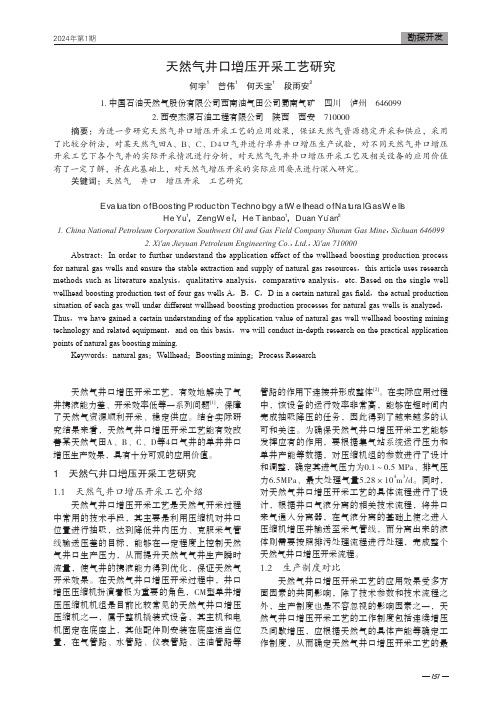
151天然气井口增压开采工艺,有效地解决了气井携液能力差、开采效率低等一系列问题[1],保障了天然气资源顺利开采、稳定供应。
结合实际研究结果来看,天然气井口增压开采工艺能有效改善某天然气田A、B、C、D等4口气井的单井井口增压生产效果,具有十分可观的应用价值。
1 天然气井口增压开采工艺研究1.1 天然气井口增压开采工艺介绍天然气井口增压开采工艺是天然气开采过程中常用的技术手段,其主要是利用压缩机对井口位置进行抽吸,达到降低井内压力、克服采气管线输送压差的目标,能够在一定程度上控制天然气井口生产压力,从而提升天然气气井生产瞬时流量,使气井的携液能力得到优化,保证天然气开采效果。
在天然气井口增压开采过程中,井口增压压缩机扮演着极为重要的角色,CM型单井增压压缩机机组是目前比较常见的天然气井口增压压缩机之一,属于整机撬装式设备,其主机和电机固定在底座上,其他配件则安装在底座适当位置,在气管路、水管路、仪表管路、注油管路等管路的作用下连接并形成整体[2]。
在实际应用过程中,该设备的运行效率非常高,能够在短时间内完成抽吸降压的任务,因此得到了越来越多的认可和关注。
为确保天然气井口增压开采工艺能够发挥应有的作用,要根据集气站系统运行压力和单井产能等数据,对压缩机组的参数进行了设计和调整,确定其进气压力为0.1~0.5 MPa、排气压力6.5MPa、最大处理气量5.28×104m 3/d。
同时,对天然气井口增压开采工艺的具体流程进行了设计,根据井口气液分离的相关技术流程,将井口来气通入分离器,在气液分离的基础上使之进入压缩机增压并输送至采气管线,而分离出来的液体则需要按照排污处理流程进行处理,完成整个天然气井口增压开采流程。
1.2 生产制度对比天然气井口增压开采工艺的应用效果受多方面因素的共同影响,除了技术参数和技术流程之外,生产制度也是不容忽视的影响因素之一,天然气井口增压开采工艺的工作制度包括连续增压及间歇增压,应根据天然气的具体产能等确定工作制度,从而确定天然气井口增压开采工艺的最天然气井口增压开采工艺研究何宇1 曾伟1 何天宝1 段雨安21. 中国石油天然气股份有限公司西南油气田公司蜀南气矿 四川 泸州 6460992. 西安杰源石油工程有限公司 陕西 西安 710000摘要:为进一步研究天然气井口增压开采工艺的应用效果,保证天然气资源稳定开采和供应,采用了比较分析法,对某天然气田A、B、C、D4口气井进行单井井口增压生产试验,对不同天然气井口增压开采工艺下各个气井的实际开采情况进行分析,对天然气气井井口增压开采工艺及相关设备的应用价值有了一定了解,并在此基础上,对天然气增压开采的实际应用要点进行深入研究。
石油与天然气介绍英语作文
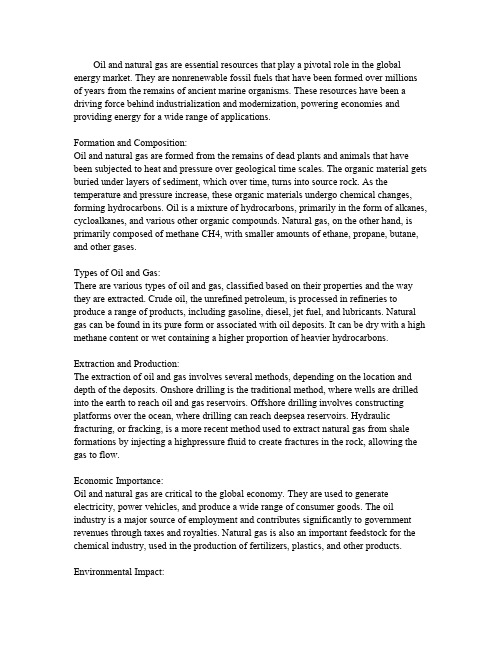
Oil and natural gas are essential resources that play a pivotal role in the global energy market.They are nonrenewable fossil fuels that have been formed over millions of years from the remains of ancient marine organisms.These resources have been a driving force behind industrialization and modernization,powering economies and providing energy for a wide range of applications.Formation and Composition:Oil and natural gas are formed from the remains of dead plants and animals that have been subjected to heat and pressure over geological time scales.The organic material gets buried under layers of sediment,which over time,turns into source rock.As the temperature and pressure increase,these organic materials undergo chemical changes, forming hydrocarbons.Oil is a mixture of hydrocarbons,primarily in the form of alkanes, cycloalkanes,and various other organic compounds.Natural gas,on the other hand,is primarily composed of methane CH4,with smaller amounts of ethane,propane,butane, and other gases.Types of Oil and Gas:There are various types of oil and gas,classified based on their properties and the way they are extracted.Crude oil,the unrefined petroleum,is processed in refineries to produce a range of products,including gasoline,diesel,jet fuel,and lubricants.Natural gas can be found in its pure form or associated with oil deposits.It can be dry with a high methane content or wet containing a higher proportion of heavier hydrocarbons.Extraction and Production:The extraction of oil and gas involves several methods,depending on the location and depth of the deposits.Onshore drilling is the traditional method,where wells are drilled into the earth to reach oil and gas reservoirs.Offshore drilling involves constructing platforms over the ocean,where drilling can reach deepsea reservoirs.Hydraulic fracturing,or fracking,is a more recent method used to extract natural gas from shale formations by injecting a highpressure fluid to create fractures in the rock,allowing the gas to flow.Economic Importance:Oil and natural gas are critical to the global economy.They are used to generate electricity,power vehicles,and produce a wide range of consumer goods.The oil industry is a major source of employment and contributes significantly to government revenues through taxes and royalties.Natural gas is also an important feedstock for the chemical industry,used in the production of fertilizers,plastics,and other products.Environmental Impact:Despite their benefits,the extraction and use of oil and natural gas have significant environmental implications.The burning of fossil fuels contributes to air pollution and climate change.Oil spills,such as the Deepwater Horizon disaster in2010,can have devastating effects on marine ecosystems.Methane,a potent greenhouse gas,can be released during the extraction and transportation of natural gas,contributing to global warming.Future Prospects:As the world seeks to transition to a more sustainable energy future,the role of oil and natural gas is evolving.Renewable energy sources,such as solar and wind power,are becoming more prominent,but oil and gas are expected to remain important for the foreseeable future.Advances in technology,such as carbon capture and storage,may help mitigate the environmental impact of fossil fuels.Additionally,the development of biofuels and hydrogen as alternative energy sources could reduce reliance on oil and natural gas.In conclusion,oil and natural gas are complex resources with a profound impact on the global economy and environment.As we move towards a more sustainable future,it is essential to balance the need for energy with the imperative to protect our planet for future generations.。
抓住低油价机遇积极获取优质油气资产

世界石油工业World Petroleum Industry第27卷 第5期 2020年10月V ol.27 No.5 Oct., 202052产业经济Industrial EconomyI抓住低油价机遇积极获取优质油气资产窦立荣,肖伟,刘贵洲(中国石油国际勘探开发有限公司,北京 100034)摘要:为优化公司资产结构、聚焦核心业务,资产并购已成为石油公司快速发展的重要手段。
受新冠肺炎疫情和低油价的影响,2020年上半年全球油气资产收并购是近20年来同期的最低点。
2020年7月雪佛龙公司以144亿美元收购诺贝尔能源公司给全球油气工业的复苏带来了一丝曙光。
通过分析发现,高负债是油公司/资产被收购的主因,优质储/产量、协同创效和投资组合的互补是交易的价值所在,深水和环非洲圈是交易的热点地区。
建议中国的石油公司抓住低油价的机遇,立足环非洲圈,密切跟踪一批大型石油公司拟剥离的优质油气项目和拥有优质油气储量的中小公司,注重低碳资产,创新交易方式,稳妥开展技术经济评价,力争获得几个拥有优质油气储量和较大勘探潜力的项目。
关键词:石油公司;低油价;油气资产;收并购;协同效应;环非洲圈;深水领域中图分类号:TE-9 文献标识码:ASeize the opportunity of low oil price to acquire high-qualityoil & gas assets activelyDOU Lirong, XIAO Wei, LIU Guizhou(China National Oil and Gas Exploration and Development Company Ltd., Beijing 100034, China)Abstract: In order to optimize the company ’s portfolios and focus on the core business, mergers and acquisitions (M&A) of assets has become an important approach for the rapid development of oil companies. Affected by COVID-19 epidemic and low oil price, the first half of 2020 is the lowest year-to-year period for the M&A of oil and gas assets in the past 20 years. Chevron ’s $14.4 billion acquisition of Nobel Energy in July 2020 offers a glimmer of hope for the recovery of the global oil and gas industry. Through analysis, this paper finds that high debt is the main reason for oil companies or assets to be acquired, high quality reserves and production, run-rate synergy and portfolio complementarity are where the transaction value lies, and deep water frontiers and the circle-Africa are the hot spots for the transaction. It is suggested for Chinese oil companies to seize the opportunity of low oil price, to focus on the circle-Africa and deep water frontiers, closely to track a number of high-quality oil & gas assets which are planned to be stripped by super-majors and small and medium-sized companies which have high-quality reserves, to innovate the M&A methods, and finally to acquire several assets which have high-quality reserves or good exploration potential.Keywords: oil company; low oil price; oil &gas assets ;merger and acquisition; run-rate synergy; circle-Africa; deep water frontier2020年新冠肺炎疫情蔓延导致的全球经济衰退和史上首次出现的负油价这两只“黑天鹅”,预示着百年未有之大变局的来临。
管道防腐技术在油气储运中的全程应用
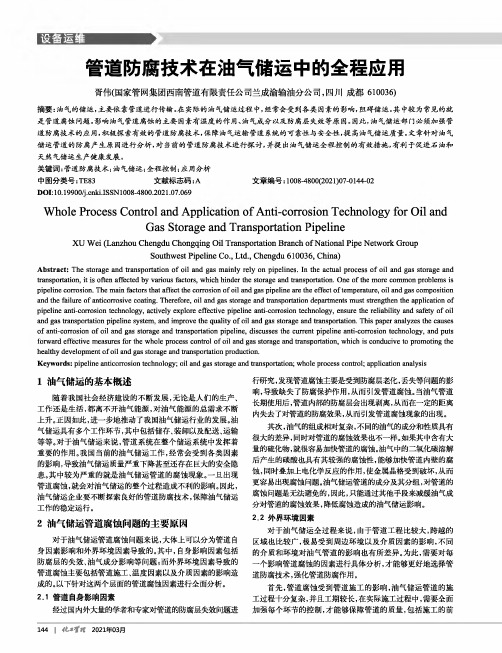
管道防腐技术在油气储运中的全程应用胥伟(国家管网集团西南管道有限责任公司兰成渝输油分公司,四川成都610036)摘要:油气的储运,主要依靠管道进行传输。
在实际的油气储运过程中,经常会受到各类因素的影响,阻碍储运。
其中较为常见的就是管道腐蚀问题。
影响油气管道腐蚀的主要因素有温度的作用、油气成分以及防腐层失效等原因。
因此,油气储运部门必须加强管道防腐技术的应用,积极探索有效的管道防腐技术,保障油气运输管道系统的可靠性与安全性,提高油气储运质量。
文章针对油气储运管道的防腐产生原因进行分析,对当前的管道防腐技术进行探讨,并提出油气储运全程控制的有效措施,有利于促进石油和天然气储运生产健康发展。
关键词:管道防腐技术;油气储运;全程控制;应用分析中图分类号:TE83文献标志码:A文章编号:1008-4800(2021)07-0144-02DOI:10.19900/ki.ISSNl008-4800.2021.07.069Whole Process Control and Application of Anti-corrosion Technology for Oil andGas Storage and Transportation PipelineXU Wei(Lanzhou Chengdu Chongqing Oil Transportation Branch of N ational Pipe Network GroupSouthwest Pipeline Co.,Ltd.,Chengdu610036,China)Abstract:The storage and transportation of oil and gas mainly rely on pipelines.In the actual process of oil and gas storage and transportation,it is often affected by various factors,which hinder the storage and transportation.One of the more common problems is pipeline corrosion.The main factors that affect the corrosion of oil and gas pipeline are the eflect of temperature,oil and gas composition and the failure of anticorrosive coating.Therefore,oil and gas storage and transportation departments must strengthen the application of pipeline anti-corrosion technology,actively explore effective pipeline anti-corrosion technology,ensure the reliability and safety of oil and gas transportation pipeline system,and improve the quality of oil and gas storage and transportation.This paper analyzes the causes of anti-corrosion of oil and gas storage and transportation pipeline,discusses the current pipeline anti-corrosion technology,and puts forward effective measures for the whole process control of oil and gas storage and transportation,which is conducive to promoting the healthy development of oil and gas storage and transportation production.Keywords:pipeline anticorrosion technology;oil and gas storage and transportation;whole process control;application analysis1油气储运的基本概述行研究,发现管道腐蚀主要是受到防腐层老化,丢失等问题的影随着我国社会经济建设的不断发展,无论是人们的生产、工作还是生活,都离不开油气能源,对油气能源的总需求不断上升。
中石油2016通用英语选读课文16
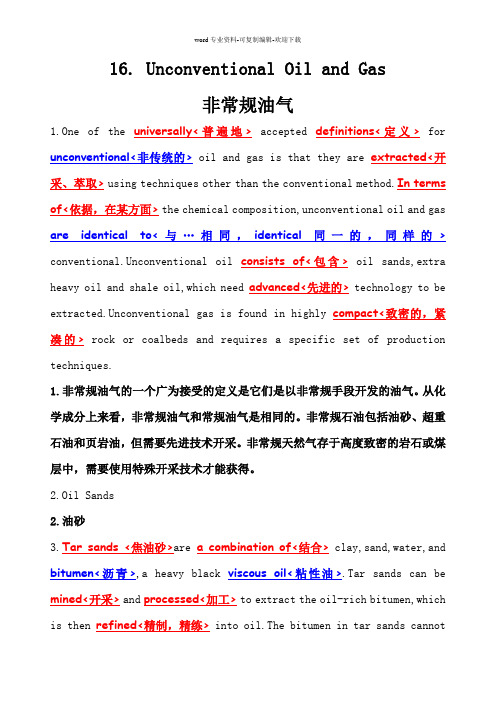
16. Unconventional Oil and Gas非常规油气1.One of the universally<普遍地>accepted definitions<定义>for unconventional<非传统的> oil and gas is that they are extracted<开采、萃取>using techniques other than the conventional method.In terms of<依据,在某方面>the chemical composition,unconventional oil and gas are identical to<与…相同,identical同一的,同样的> conventional.Unconventional oil consists of<包含>oil sands,extra heavy oil and shale oil,which need advanced<先进的> technology to be extracted.Unconventional gas is found in highly compact<致密的,紧凑的>rock or coalbeds and requires a specific set of production techniques.1.非常规油气的一个广为接受的定义是它们是以非常规手段开发的油气。
从化学成分上来看,非常规油气和常规油气是相同的。
非常规石油包括油砂、超重石油和页岩油,但需要先进技术开采。
非常规天然气存于高度致密的岩石或煤层中,需要使用特殊开采技术才能获得。
2.Oil Sands2.油砂3.Tar sands <焦油砂>are a combination of<结合> clay,sand,water,and bitumen<沥青>,a heavy black viscous oil<粘性油>.Tar sands can be mined<开采>and processed<加工>to extract the oil-rich bitumen,which is then refined<精制,精练> into oil.The bitumen in tar sands cannotbe pumped<注入>from the ground in its natural state<自然状态>;instead tar sand deposits are mined,usually using strip mining<露天开采> or open pit<采石场,露天开采> techniques,or the oil is extracted by underground heating with additional upgrading.3.焦油砂是一种粘土、砂、水和沏青(一种重质黑色稠油)的混合物。
- 1、下载文档前请自行甄别文档内容的完整性,平台不提供额外的编辑、内容补充、找答案等附加服务。
- 2、"仅部分预览"的文档,不可在线预览部分如存在完整性等问题,可反馈申请退款(可完整预览的文档不适用该条件!)。
- 3、如文档侵犯您的权益,请联系客服反馈,我们会尽快为您处理(人工客服工作时间:9:00-18:30)。
(Rel. 17–2009)Reprinted from Doing Business in China, pgs. V-3.1 – V-3.33, copyright 2009 © Juris Publishing, Inc., V. INDUSTRY SECTOR REPORTSChapter 3Upstream Oil and Gas in ChinaDavid Blumental, Tju Liang Chua and Ashleigh Au ∗____________SYNOPSIS§ 3.01 Introduction[1] Growth in Energy Consumption and Production[2] Securing Energy Supply[a] Coal[b] Oil[c] Natural Gas & Liquefied Natural Gas[d] Coal-Bed Methane[3] Demand-Side Reduction[4] Environmental Situation[5] The Chinese Energy Industry∗ David Blumental is the Chief Representative and Managing Partner of the Vinson & Elkins Shanghai office. His principal areas of practice are business law, international business transactions, cross-border mergers, acquisitions and divestitures as well as corporate and project finance and oil and gas. He is a member of the firm’s Energy Transactions & Projects Practice Group, Project Finance and Development Group and the China Practice Group.Tju Liang Chua is an Associate at the Vinson & Elkins Shanghai office and a member of the firm’s Energy Transactions & Projects Practice Group, and China Practice Group. His principal areas of practice are international business transactions and cross-border mergers and acquisitions with a particular focus on the energy sector. Prior to joining Vinson & Elkins in 2006, Tju Liang had been based in London, Jakarta, and Singapore.Ashleigh Au is a paralegal at the Vinson & Elkins, LLP Shanghai office.DOING BUSINESS IN CHINA V-3.2(Rel. 17–2009)[a] China National Petroleum Company (CNPC) & PetroChina[b] Sinopec[c] China National Offshore Oil Corporation (CNOOC)[d] Sinochem[e] Other players[6] Foreign participation in China's energy industry[a] Early 1980s[b] 1990s to Present[c] Recent trends§ 3.02 Regulation of the Upstream Oil & Gas Industry[1] Regulatory Authorities[a] National Energy Administration (NEA)[b] Ministry of Land and Natural Resources[c] Ministry of Commerce (MOFCOM)[d] Ministry of Environmental Protection[e] State Maritime Administration[f] China Offshore Oil Operation Safety Office[g] State Administration of Work Safety[h] State Energy Committee[2] Laws & Regulations[a] Onshore Regulations[b] Offshore Regulations[c] Royalties[3] Taxes[a] Windfall Tax[b] Crude Oil Export Tax§ 3.03 Oil & Gas Contracts[1] Overview[2] Crude Oil Production Sharing Contracts[a] Contract Term[b] Operator[c] JMC[d] Exploration[e] Minimum Work/Expenditure Commitments[f] Discovery; Determination of CommercialityV-3.3 UPSTREAM OIL AND GAS IN CHINA § 3.01[1](Rel. 17–2009)[g] Natural Gas Discoveries[h] Relinquishment[i] Development: ODP and Work Programs[j] Payments, Financing and Cost Recovery[k] Taxes[l] Quality, Quantity and Price of Crude Oil[m] Ownership of Assets and Data[n] Marketing[o] Local Content Requirements[p] Governing Law and Language[q] Consultation and Arbitration[3] Coal-Bed Methane Production Sharing Contracts[a] Contract Term[b] Operator[c] Minimum Work/Expenditure Commitments[d] Relinquishment[e] Price of CBM[f] Local Employment[g] Destination of CBM and Marketing[4] Joint Study Agreements and Geophysical Survey Agreements § 3.04 Conclusion§ 3.01 IntroductionWith the recent drastic changes in global crude oil prices first rising to record levels of around US$147 a barrel in July 2008, and then crashing to around US$35.98 (US$35) a barrel in December 2008, the energy industry, media, governments, international agencies, and even consumers are paying special attention to China’s impact on demand in the world’s energy markets.[1] Growth in Energy Consumption and ProductionDuring the Mao era and its immediate aftermath (from 1949 until the late 1970s), China had always been a net exporter of oil. The Daqing oil fields in Heilongjiang province, discovered in 1959, are China’s§ 3.01[2]DOING BUSINESS IN CHINA V-3.4 largest oil fields and the fourth largest producing oil fields in the world. Sales of Daqing crude oil to Japan and other countries provided significant contributions of valuable foreign exchange to China. However, after the government-led liberalization of the economy in 1978, China’s demand for energy surged. To meet this rising demand, China began to consume a considerably greater amount of domestically produced oil. In 1993, China became a net importer of crude oil and since then, China has been responsible for approximately 40 percent of the growth of the world’s oil demand.Since 2000, China’s energy demand has rapidly increased as the economy has grown between nine and ten percent each year. In late 2003, China surpassed Japan to become the world’s second largest consumer of petroleum after the United States. The following year, China ceased all oil exports to Japan. By the end of 2007, China imported nearly half of its crude demand, and had to cut crude exports by nearly 40 percent.Although demand has risen steadily in recent years, the growth of Chinese domestic crude oil production has not kept up to pace with its energy needs. Total imports of crude oil have increased nearly 140 percent from 1.38 million barrels per day in 2002 to roughly 3.8 million barrels per day in 2008.The International Energy Agency (IEA) predicted in 2007 that by 2012 Chinese demand would grow to 9.96 million barrels per day. However, since the 2008 economic crisis, IEA forecasts have been repeatedly revised in response to the precarious state of world markets as China’s demand has been subject to speculation. Nonetheless, as the future of China’s economic development and stability relies on energy supply, the issue of satisfying energy demand remains at the forefront.[2] Securing Energy SupplyThe rapid increase in domestic energy demand means that securing stable sources of energy for the near-, medium- and long-term has been the most challenging issue facing China’s leadership and industry players. The Chinese government has approached this issue with a multi-pronged plan: demand-side reductions through conservation and(Rel. 17–2009)V-3.5 UPSTREAM OIL AND GAS IN CHINA § 3.01[2] efficiency improvements, as well as an expanded focus on renewable energy and overseas oil and gas acquisitions.[a] CoalCoal is China’s main source of energy, accounting for nearly 70 percent of domestic energy supply, and China possesses the world’s largest coal reserves. However, China’s coal mining industry is hampered by weak organization and supervision, poor safety procedures (mine explosions and collapses are frequent occurrences), and significant bottlenecks in the transportation of coal from mining regions to large end-users in coastal areas. The environmental cost of inefficient coal mining combined with the combustion of coal and fuel oil has proven significant—China is the world’s largest producer of carbon dioxide emissions and often suffers from severe air and water pollution. Furthermore, China’s energy consumption is noticeably less efficient than that of the U.S., Japan, and other industrialized countries. In other words, China consumes more energy to produce the same economic value.[b] OilChinese policymakers and state-owned oil companies have embarked on a multi-pronged approach to improve oil security by purchasing equity oil stakes abroad, diversifying suppliers, enacting new policies to lower demand, investing in energy substitutes, building strategic oil reserves, and maximizing domestic production. Accordingly, China’s emerging oil companies are being recognized as significant players in international exploration and production (E&P), oilfield services, and liquefied natural gas (LNG) projects worldwide.In pursuit of this multi-pronged strategy, China has endorsed overseas equity investment and entered a range of contracts from the most basic to the most complex with various foreign nations. Importing up to 45 percent of its energy needs, China’s interests lie in supply diversification. As such, Chinese oil companies have actively pursued projects in the Middle East and Africa, as well as in North and South America in more recent years.China has also joined many Western nations in establishing strategic petroleum reserves to provide a buffer against disruptions in the supply of imported crude oil. China desires to maximize domestic production,(Rel. 17–2009)§ 3.01[2]DOING BUSINESS IN CHINA V-3.6 and in the past decade has gone to extensive and expensive lengths to do so: building several trans-national pipelines, including the 4000 km West-East pipeline at a cost of more than US$24 billion, and engaging in exploration in remote areas such as Xinjiang. Recent government measures to optimize domestic production include proposals to toughen block exploration and production licensing and raise the minimum investment and exploration obligations of national oil companies.[c] Natural Gas & Liquefied Natural GasNatural gas has not been a major fuel resource in China’s past. Several significant hurdles exist for the development of the natural gas market within China:(a) First, natural gas is expensive compared to coal ifenvironmental costs are not included.(b) Second, China is not believed to be endowed with abundantand cheap gas reserves, and known supplies are often locatedfar from the main centers of demand. Recent estimates ofChina’s proven domestic natural gas reserves ranged from 1.51to 2.35 trillion cubic meters.(c) Third, China lacks a well-developed legal and regulatoryframework to encourage investment in the gas sector. Chinadoes, however, govern such matters as pricing and long-termtake or pay contracts.(d) Fourth, there is a lack of knowledge over how to best developnatural gas technology and markets.(e) Finally, China’s gas supply infrastructure is fragmented andwould require substantial investment to finance its expansion. The weakest link in China’s natural gas chain is the perception that high costs result in a weak demand for gas. While the government is beginning to address this issue, without a stronger market pull for gas, the entire natural gas chain remains weak, irrespective of efforts to develop the market by administrative direction.Notwithstanding the challenges, China’s government has been pushing for natural gas to take on a larger role in China’s present and future. As a part of the 2005 11th Five-Year Plan to curb pollution, the(Rel. 17–2009)V-3.7 UPSTREAM OIL AND GAS IN CHINA § 3.01[2] government set a target of making natural gas 5.3 percent of domestic energy consumption by 2010. This marks a consumption increase from the 2.8 percent consumed in 2005, but falls somewhat lower than the 8 percent the government has targeted since 1999. In order to meet these targets, various state-owned oil companies have begun work on many natural gas projects designed to increase the supply of natural gas in China.In recent years, China has made efforts to improve the interconnectivity of its natural gas pipelines. As a result, the distribution network in Sichuan province, where a significant amount of gas reserves lie, has become China’s most advanced natural gas distribution network. Additionally, the West-East natural gas pipeline that stretches from Xinjiang to Shanghai began operations in January 2005. Currently, the West-East pipeline operates under capacity due to lack of gas.China’s first liquefied natural gas (LNG) import terminal, with a capacity of 3.3 million metric tons per year, began operations in Guangdong province in May 2006. A second LNG import terminal in Fujian province, with a capacity of 2.41 million metric tonnes per year, received its first shipment in April 2008, well ahead of the 2009 target date for opening production. Many more projects are in the planning and construction stages including a long-term agreement with Shell that will import LNG from Qatar, a China National Petroleum Corporation (CNPC) LNG terminal in Dalian, a Sinopec terminal in Qingdao, and seven more terminals by China National Offshore Oil Corporation (CNOOC) alone. These projects aim to provide the 200bcm of natural gas estimated to be in demand by 2020.[d] Coal-Bed MethaneIn recent years, China has expanded its domestic energy sources to include coal-bed methane (CBM). Previously, CBM was viewed exclusively as a problem, with the presence of methane in China’s coal mines causing frequent mine explosions and collapses. The expansion of CBM extraction has dual benefits: improving the safety of coal extraction work, and supplying a cleaner, additional source of fuel to meet energy demands. It is estimated that China has over 37 trillion cubic meters of reserves.China United CoalBed Methane (CUCBM), a joint venture between PetroChina and China National Coal Group, was founded in(Rel. 17–2009)§ 3.01[3] DOING BUSINESS IN CHINA V-3.8 (Rel. 17–2009)1996 to develop CBM with foreign companies and enhance exploration activities. The discovery of 75.4 billion cubic meters of CBM reserves in the Qingshui basin in Shanxi province led to the CUCBM’s first commercial CBM project, Shanxi Panhe, which did not produce commercial gas. By 2006, about 1,000 CBM test and pilot wells were completed within more than 30 basins by domestic and foreign companies, none of which led to commercial production. China’s CBM has remained a largely under-exploited resource. Only 700 million cubic meters of CBM have been produced to date falling short of the 2005 central government energy plan (the 11th Five-Year Plan) target to extract ten billion cubic meters of CBM per year by 2010. Lagging development, however, has paved the way for the reshaping of China’s regulatory structure and the encouraging foreign investment in the industry. As a result, the State Council took away CUCBM’s monopoly on forging alliances with foreign investors in 2007 and in April 2009, the State-Owned Assets Supervision and Administration Commission announced the division of CUCBM’s assets between PetroChina and the China National Coal Group. The separation of this joint venture, which was perceived to be unsuccessful, signals China’s desire to accelerate development and meet the 11th Five-Year Plan production targets. Plans to develop the commercialization of CBM include the construction of ten CBM pipelines, with the first one due for completion by the end of 2009.[3] Demand-Side ReductionIn an effort to reduce the country’s reliance on coal reserves, China is seeking demand-side reductions through more efficient energy production and consumption while actively seeking out energy producing substitutes. The central government’s energy plan, the 11th Five-Year Plan promulgated in 2005, calls for “accelerated development” of oil and natural gas, “aggressive development” of electricity, and a push to “greatly” develop renewable energy sources. The Chinese government has made it a national priority to develop diversified, clean, and more efficient energy sources, including oil and natural gas, clean coal technology and, to a growing extent, renewable energy sources such as wind, geothermal and solar power.V-3.9 UPSTREAM OIL AND GAS IN CHINA § 3.01[5](Rel. 17–2009)[4] Environmental SituationThough government measures have encouraged a shift away from energy-intensive industries such as steel manufacturing, the real demands of economic growth often translate into efficiency taking precedence over conservation. However, while measures implemented to increase energy efficiency and reduce energy demand offer some mitigating effect, the problem of long-term energy supply remains unresolved. Notwithstanding recent reports by the China State Statistics Bureau showing an annual 15 percent increase in total energy production, demand for energy continues to rise on the back of rapid economic growth and the country’s potential energy shortage is becoming increasingly acute.[5] The Chinese Energy IndustryThe modern Chinese petroleum industry was created in large part in 1998 when the Chinese government mandated the restructuring of state-owned assets to establish CNPC in the north of the country and China Petrochemical Corporation (Sinopec) in the south. Prior to restructuring, CNPC had been engaged in upstream exploration and production throughout China since 1988 when it replaced the Ministry of Petroleum Industry. Sinopec was engaged in mid/downstream refining and distribution. A third firm, CNOOC, presided over most offshore oil and gas production and has managed to retain its pre-1998 control since restructuring. All three of the Chinese majors have restructured and conducted relatively successful international IPOs.[a] China National Petroleum Company (CNPC) & PetroChina Created from the former Ministry of Petroleum, China National Petroleum Corporation (CNPC) is the largest of the state-owned oil companies. In early 2000, CNPC invested most of its high quality assets into its subsidiary PetroChina Company Limited. PetroChina made an IPO of a minority interest on the New York and Hong Kong stock exchanges in April 2000, with its market capitalization rising over US$3 billion. British Petroleum was the largest purchaser, subscribing for 20 percent of the shares offered. Warren Buffet was another major investor. The IPO, which was originally intended to raise US$7 billion, was scaled back due to labor and human rights groups who objected to CNPC’s§ 3.01[5]DOING BUSINESS IN CHINA V-3.10 involvement in a controversial development project in Sudan. Nonetheless, CNPC investment in Sudan yielded record highs of crude output exceeding 11 million tonnes in 2008. CNPC has also expanded into overseas oil and gas exploration in Iraq where the company aims to increase oil and gas production by 5% annually and reach a capacity of 25,000 barrels per day within six years.Since listing, PetroChina has enjoyed consistent growth, and has solidified its position among the world’s most important companies. In 2008, the Financial Times released its twelfth Global 500 list, which measures the world’s most important companies based on evaluation incorporating stock market listing and market perception. With a market value of US$424 billion, CNPC ranked second on the list between ExxonMobil and General Electric.PetroChina’s subsidiaries include Jinzhou Petrochemical Co. Ltd., Liaohe Jinma Oilfield Co. Ltd., and Jinlin Chemical Industry Co. Ltd. [b] SinopecSinopec is the second largest of the Chinese state-owned oil companies. In October 2000, Sinopec’s IPO in Hong Kong and New York raised approximately US$3.5 billion from the offering and sale of a 15% minority stake. Approximately US$2 billion of the offering was purchased by ExxonMobil, BP, and Shell. However, Sinopec’s offering was also scaled back due to weakness in the international equity markets. ExxonMobil, BP and Shell have all since sold off the shares they acquired during Sinopec’s IPO.In November 2007, Sinopec issued shares on the Shanghai stock exchange. As a result, Sinopec’s market share tripled. While PetroChina enjoys the larger market share, Sinopec has often been the highest earning company in China. It was the only company to earn more than one trillion yuan in 2006. In the 2008 Global 500, released by the Financial Times, Sinopec ranked as the 37th most important company in the world.Sinopec’s subsidiaries include Shanghai Petrochemical Co. Ltd., Fujian Petrochemical Co. Ltd., and 17 smaller subsidiaries.(Rel. 17–2009)V-3.11 UPSTREAM OIL AND GAS IN CHINA § 3.01[5][c] China National Offshore Oil Corporation (CNOOC) CNOOC was established in 1982 for the purpose of administering offshore petroleum operations with foreign entities. Today CNOOC maintains exclusive rights to offshore petroleum exploration and production, although in 2002 it spun off oilfield services to China Oilfield Service, Ltd. (COSL). While the spin-off is now listed on the Hong Kong stock exchange, the Chinese government maintains majority control of COSL.Since listing, CNOOC has been a leader in overseas M&A. In 2005 CNOOC attempted to acquire the American Union Oil Company of California. The attempt set off a political storm in the United States amid concerns of a Chinese company gaining control over American energy. This failed attempt aside, CNOOC has fared well in M&A and remains the domestic leader in LNG.[d] SinochemSinochem is China’s petroleum and petrochemical trading company. While trading has traditionally been their main function, they have expanded greatly this decade. In 2002, Sinochem established Sinochem Petroleum Exploration and Production Company, Ltd. to engage in overseas E&P acquisitions. By 2006, they had become fully engaged in a wide range of up-, mid-, and downstream sectors.[e] Other playersShaanxi Yanchang Petroleum Group Company is a state-owned company formed in 2005 through the merger of 21 private exploration and development companies and three refineries. Shaanxi Yanchang is China’s fourth-largest oil company.China United Coal Bed Methane Company (CUCBM) is a state-owned company formed in 1996 to facilitate the development of coal-bed methane projects. From 2001 through 2007, government regulations granted CUCBM the exclusive right to cooperate with foreign partners in the development of coal-bed methane projects. This privilege, however, was expanded to other companies with state council approval in 2007.China Zhenhua Oil, a wholly owned subsidiary of North China Industrial Group (NORINCO), was formed in 2004. Zhenhua’s(Rel. 17–2009)§ 3.01[6]DOING BUSINESS IN CHINA V-3.12 expansion into overseas investment has led to projects in Kazakhstan, Iraq and Pakistan. Recent developments include the signing of a share purchase agreement in Kazakhstan making Zhenhua the controlling shareholder of the K&B Oilfield with 75% interest. In 2008 Zhenhua also signed a Production Sharing Contract with a CNPC affiliate in the Ahdeb Oil Field in Iraq. The company has also revealed plans to invest over US$30 million drilling in Basca and Bahawapul, Pakistan.In December 2004, private oil companies formed an association under Gongshanglian, the China Chamber of Commerce for the Petroleum Industry (CCCPI), which at that time had about 140 member companies. In June 2006, under CCCPI’s coordination, China’s largest private firms unified to form the Great United Petroleum Holding Co., Ltd. (GUPC). At its establishment, the conglomerate announced its possession of capital at about RMB5 billion (US$603.9 million). GUPC hopes to give private firms a platform from which to compete with large state-owned oil companies in order to develop operations in China and acquire upstream assets overseas. To date, they have yet to achieve much success.[6] Foreign Participation in China’s Energy Industry[a] Early 1980sThe 1980s marked the beginning of the reformation era for the oil and gas industry. Prior to this time, activity was very limited and legal framework presented a blank slate. Spurred by the need for foreign capital, technology, and know-how, China took the first step in Sino-foreign cooperative exploration by signing five bilateral petroleum contracts in 1979. The bidding procedures for Sino-foreign cooperative exploration followed shortly. In 1982 and 1983, the PRC promulgated very early regulations that would lay the framework for today’s oil and gas industry. These laws provided for the most basic production sharing contracts in the form of petroleum contracts. These investment risk contracts were designed to both attract foreign investment and benefit China through provisions that mandated the transfer of technology and industry acumen. In the late 1980s, gradual price reform took place with the development of the market. China’s two-tiered plan to incorporate both a planned economy and a market economy signaled a milestone for foreign investment in the PRC.(Rel. 17–2009)V-3.13 UPSTREAM OIL AND GAS IN CHINA § 3.01[6][b] 1990s to PresentIn the 1990s China took continued interest in foreign investment. As more companies became interested in China, production sharing contracts gradually became more sophisticated. With the opening of the midstream, foreign enterprises showed only limited interest in this sector. Domestic companies continued to carry out most midstream operations.In 2002, government regulations encouraged the “construction and operation of oil (gas) pipelines” by foreign enterprises. Initially few investors were eager to take advantage of the opportunity. To date, foreign firms are involved in pipelines and pipeline construction, but they have generally been run by Chinese companies. GE Oil & Gas will be providing eight centrifugal compressors for the Sichuan-Shanghai pipeline, while Sinopec will have oversight. The West-East pipeline was originally supposed to be a joint venture between a subsidiary of Sinopec and three foreign companies, but PetroChina terminated the arrangement two years after operations began. Domestic companies continue to dominate many other aspects of midstream operation. In 2006, in order to comply with its WTO (World Trade Organization) commitments, China opened the wholesale market to foreign competition and in 2007, 25 foreign private companies were granted the right to store and sell crude and processed oil in China. However, strict technical requirements provide great barriers to entering the market. As a result, most wholesale and retail operations are wholly or mostly run by Sinopec or CNPC.[c] Recent TrendsSince China joined the World Trade Organization In December 2001, newly promulgated amendments to the principal regulations governing foreign participation in onshore and offshore upstream petroleum projects have brought regulations in line with China’s WTO commitments.One of the most significant steps towards WTO accession was the revision of the Regulation of the People’s Republic of China on Sino-Foreign Cooperation of both Continental and Offshore Petroleum Resources 2003. These revisions expanded opportunities for foreign companies in China, yet entering China for exploration still required a partnership with a Chinese SOE. These regulations were amended(Rel. 17–2009)§ 3.02[1] DOING BUSINESS IN CHINA V-3.14 (Rel. 17–2009)again in 2007, but with few changes. In general, as expressed by the Secretariat of the WTO, recently “there have been no major changes in policies concerning China’s energy sector, which continues to be characterized by a high level of state ownership, regulation and limited competition.”While this outlook seems generally true with regards to downstream activities, China has indicated great interest in foreign cooperation in production and exploration. China began a strategic oil reserve system in 2004 in order to provide increased energy security to accommodate growing demand. The 11th Five-Year Energy Plan also outlines aims to increase oil reserves.In addition, investments in risk exploration, development and production of petroleum and natural gas, as well as investments relating to new technologies for petroleum exploration and development are listed as “encouraged” industries in the 2007 Catalogue of Foreign Investment Industries (外商投资产业指导目录 (2007 Catalogue). The 2007 Catalogue sets out detailed lists of industries and specific activities according to whether foreign investment is encouraged, restricted, or prohibited. It should be noted that the 2007 Catalogue expressly requires that foreign investment in such petroleum activities be pursued in cooperation with Chinese partners.§ 3.02 Regulation of the Upstream Oil & Gas Industry[1] Regulatory AuthoritiesOne of the biggest problems faced by the Chinese government in formulating and implementing a national energy policy and administering the country’s energy industry has been the lack of a single regulatory body with sufficient authority to carry out regulatory functions. Since 1993, when the Ministry of Energy (能源部) was dismantled, regulatory oversight has been fragmented among different regulatory bodies. Authority has shifted with each subsequent restructuring of the government.In 1998, China carried out an aggressive bureaucratic restructuring plan that slashed the number of ministries from 40 to 29. As part of this plan, the regulation of the petroleum industry was transferred away。
